If you would like a printed copy of any of our back issues, then they can be purchased on Farm Marketplace. You can also download the PDFs or read online from links below.
-
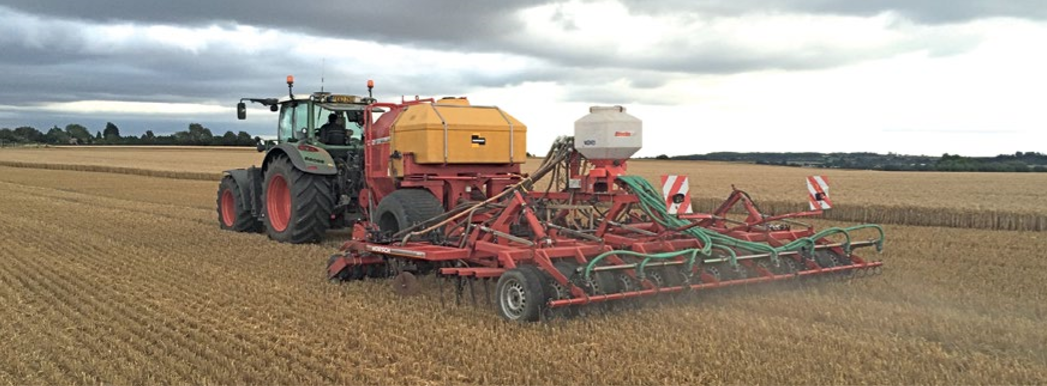
How To Start Drilling For £8K
Clive Bailye’s seed drill of choice is his 6m John Deere 750A , which has been used exclusively for 3-4 seasons. Last year, with an increased acreage, the founder and publisher of this Direct Driller magazine thought a second seed drill was necessary. Having just the one machine was a risk and in a difficult season would mean drilling was delayed. He looked around and found a good condition Horsch CO6 tine drill advertised in Germany.
Words and pictures by Mike Donovan
After delivery he rebuilt the coulters to a narrow profile so as to reduce soil disturbance. He says the tine drill is very useful driling after straw crops such as osr and also through the straw on second crop cereals.
Buying the drill from a German farmer was not particularly complicated, and provided him with a higher spec machine than Horsh sell in the UK. The seed dart tyres are much wider, and the machine is fitted with blockage monitors as well as full width front packers and also a liquid fert application system.
A sheaf of photos were taken, and Clive then asked for some of specific parts to show wear. The deal was done at under £5,000 which Clive says is the market value of these machines which are too large for small farmers to buy. Original owners like to buy new and sell when the machine is still in good condition.
Narrow tines with wear tiles
@Clive knew he wanted to make changes, substituting the Horsch tines and coulters for something far narrower, and has ended up getting his own design of tine made, which has a wear tile made from Ferobide, far harder than tungsten. The drill is on the farm primarily for osr and 2nd crop cereals drilled into chopped straw and the 25cm spacing is okay for these crops.
Comments on Clive’s on-line forum, TFF, said the drill many not be so good with beans, as the slot is a mere 12mm wide. And in barley the spacing may well be too wide as it needs to be thick. Clive points out that the seed pipe can actually be a bit wider than 12mm as it is in the shadow of the point. It would be good to have the option of using it for beans.

Above left: The cheap CO6 is being calibrated ready for its first outing

Above right: The adapted Horsch is being filled by the home built drill logistics trailer with seed and liquid starter fert.
Getting around the German instructions
The Horsch came, of course, with a control box and instructions in German. More on-line discussion revealed that English instructions were available on the Horsch website, and another explained that Horsch was sourcing some of these parts from Agton in Canada anyway. Zealman from New Zealand explained that the button marked with callipers should be held down for around 5 seconds. The menu is where you adjust the tramline sequence, valve layout and row numbers.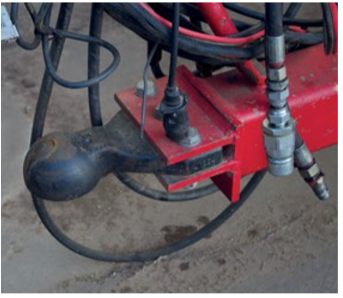
Ball hitch is a continental standard and provides a positive connection between tractor and drill

The Stocks Wizard has a rotor modified for Avadex which otherwise leaks everywhere
A Stocks Wizard is on the back of the drill and used for Avadex. Here again the knowledge of actual farmers is helpful. Alistair Nelson warned that the rotor and the surrounding shroud need to be changed, and he got good advice “from Rick at Stocks”. Clive has the same setup on the 750A and says that the Avadex leaks everywhere unless the modification is made. The drill was acquired and modified in 2016 and the results have been excellent.
The machine went through the residue without many problems and having the second drill has meant more timely planting. Clive has shown that moving into No-Till is not the expensive exercise so many farmers think it might be. The total cost, after modifications which included replacing all tines and coulters, was under £8,000.
Author Mike Donovan writes: we have featured a number of home made direct drills in @Practical Farm Ideas, and are always interested in seeing more. Please contact mike editor@farmideas.co.uk or 07778877514.
-
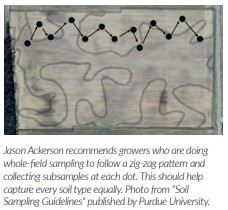
How To Create The Most Effective Soil Sampling Program
Written By Laura Barrera and first published on Agfuse
With harvest either underway or on the horizon for most growers in the U.S., now is a good time to prepare for your soil sampling program. Most universities and the NRCS recommend taking soil samples in the off-season, after the last crop harvest, and before the next cash crop is planted. Mississippi State University Extension advises collecting samples 3-6 months before planting, to allow any lime recommendations to react and change the pH. But before you can grab your soil probe and head out to the field, you need to understand best soil sampling practices and have a plan of action for collecting your samples, so you can accurately capture the soil chemistry and variability of your fields. Poor soil sampling practices can result in incorrect data, which can end up costing you in either inputs or yield.
“The foundation of understanding or making an appropriate recommendation comes from having a representative soil sample,” says Jason Ackerson, a Purdue University soil scientist. “That comes down to having a sample that’s demonstrative of the types of soil you see in that field.”
In short: The better your soil sampling program is, the more likely you are to see a return on investment from your soil and crop inputs while also producing healthier, higher-yielding crops.
Choose Your Lab
In his Soil Sampling Guidelines paper, Ackerson advises farmers to use the same lab for analysis every time they take soil samples because labs can use different methods, which may lead to different results. Using the same lab every time will ensure any changes you see are because of changes in the soil, rather than the testing.
If you’re new to soil sampling, it can help to pick out a lab before you start collecting samples, primarily for budgeting purposes. While Ackerson would never advise picking a lab solely on cost, knowing the price upfront can be helpful when considering the number of samples you plan to take and how you’re going to collect them.
“If a farmer comes to me and has a limited budget for soil sampling, it’s probably not feasible for us to recommend a high-resolution grid sample when they don’t have the resources to pay for that analysis,” he says.
In addition to price, consider whether you want just the soil test results or if you’d like additional information, such as fertilizer recommendations, as not labs will provide this. You’ll also want to make sure the lab is accredited, which should be available on the lab’s website. While most states have an accreditation system, there’s also a national accrediting laboratory body.
Finally, consider whether the lab’s testing methods are relevant to your soil’s environment. There are a couple of different ways labs can do extractions for nutrient testing, Ackerson says, and there’s usually one method they’re more comfortable with. You want to make sure those methods apply to your soil environment. For example, there are different methods for extracting phosphorus: the Bray-1 method and the Olsen method. The Olsen method is optimized for soils in more arid environments with high levels of carbonates, so it wouldn’t be ideal for a farmer in a region like Indiana to send his samples to a lab that uses it.
Determine Where You’re Going to Collect Samples
Whole-Field vs. Spatially Explicit Sampling
There are two primary strategies for choosing your sampling locations: whole field and spatially explicit. With the whole-field approach, you’ll collect several samples across the field, known as subsamples, which will then be mixed to create one composite sample. As Ackerson explains in “Soil Sampling Guidelines,” composite samples reduce the effects of soil variability and are less sensitive to unusually high or low soil test values that might occur due to concentrated fertilizer applications or natural soil variation.

Jason Ackerson recommends growers who are doing whole-field sampling to follow a zig-zag pattern and collecting subsamples at each dot. This should help capture every soil type equally. Photo from “Soil Sampling Guidelines” published by Purdue University. Whole-field sampling is most appropriate for farmers who only plan to make blanket applications in their fields. While long-term uniform applications can lead to inconsistencies, Ackerson says growers can find other ways of identifying those areas without moving to spatially explicit sampling. In some cases, they may take soil samples from specific problem areas to confirm any soil issues.
“Often a good crop scouter or agronomist can identify nutrient deficiencies based on scouting crops in the field,” Ackerson says, “but it’s good to have a soil sample there to doublecheck those symptoms are truly the result of a nutrient deficiency.”
Grids vs. Zones
If you want to make any precision applications, you’ll need to choose between grid and zone sampling. With grid sampling, you’ll lay a “grid” over the field and pull soil samples from the points in that grid, while zone sampling decides where samples should be taken based on a field’s uniform areas. So if a field has places that are heavier in clay or higher fertility, those could be separate zones.
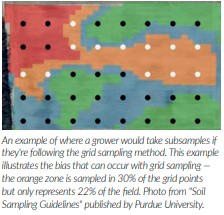
An example of where a grower would take subsamples if they’re following the grid sampling method. This example illustrates the bias that can occur with grid sampling — the orange zone is sampled in 30% of the grid points but only represents 22% of the field. Photo from “Soil Sampling Guidelines” published by Purdue University. In this example, the orange zone is sampled in 30% of the grid points (white points) but the orange zone only represents 22% of the total field. In this case, the resulting soil sample is highly biased to the soil conditions represented by the orange zone.
Zone sampling is the preferred option because grid sampling can be inefficient. Ackerson says this is due to the typical grid size of 2.5 acres, which means subsamples are often spread too far apart to capture enough field variation.
“There can often be a lot of point-topoint variabilities that can be missed in that course of a grid sample,” he explains. “To get really good spatially informed data from a grid sample, you need to sample more than most people would think about when it comes to grid resolution.”
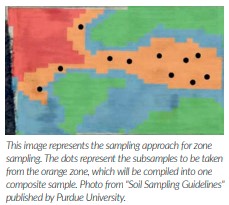
This image represents the sampling approach for zone sampling. The dots represent the subsamples to be taken from the orange zone, which will be compiled into one composite sample. Photo from “Soil Sampling Guidelines” published by Purdue University. Grid sampling can also be unintentionally biased, he adds, because there may be areas that might require a different zone that could be missed in grid sampling. For example, you may create a zone in your end rows because they tend to have a higher accumulation of chemicals caused by reloading inputs on vehicles. But the sampling points in a grid may miss those differences.
Keep Your Data Consistent
While zone sampling is the better strategy if you’re making precision applications, Ackerson doesn’t recommend changing your practice if it’s going to conflict with the data you already have.
“Someone who has been doing grid sampling may have been an early adopter of precision ag and may have 15 or 20 years of grid sampling data on their farm,” he says. “That historical record is incredibly useful when mapping the trajectory of those fields and understanding whether you see improvements in soil fertility over time.”
That historical record is often more valuable than switching to any new best practice, he adds, especially if you’ve been following best practices with that strategy. The key to good historical data is staying consistent with your program, from the location strategy you’re using to the time of year you take the samples. The times to implement a new soil sampling strategy are when you’ve acquired new land or new equipment that can make precision applications, Ackerson says.
But What if You Haven’t Been Sampling Properly?
If you learn your soil sampling program hasn’t been following best practices, should you scrap the data you already have and move to something different? It depends. One of the most common mistakes Ackerson sees in soil sampling is underestimating how variable the soils can be, even in small spatial scales, which leads to not collecting enough subsamples for a composite.
“When we start thinking about it from a statistical perspective, the number of subsamples that you need to get an accurate representation is a lot more than I think most people realize at first blush,” he explains. “Because to us taking a soil sample — you could take eight composites one year in a square area, and they’re all going to look identical. But chemically they could be vastly different.”
If not taking enough subsamples is the mistake you’ve been making with your soil sampling program, but you’ve been collecting on a good distributed grid and have had success managing it, you’re probably better off sticking with that program to stay consistent with your data.
“If you’ve been doing grid sampling but only collecting only one soil sample at each point (i.e. not collecting composite samples), any individual point may be unreliable, but take on average, there is probably useful information on the whole field,” he says. “If you start increasing the number of composites, as long as you haven’t completely changed your sampling program, it’s not necessarily going to invalidate that historical data. The data will still be useful; it’s just a matter of how reliable it is.
Focus on Capturing pH
If you’ve been doing whole-field sampling and you’re not happy with the results or looking to improve your spatially explicit sampling program, consider precision sampling for pH. Ackerson has heard ag retailers say this is often the No. 1 thing growers can do to improve their soil sampling because it provides a great return-on-investment. The reason for this is two-fold:
1. Nutrient availability and plant health
Ackerson says these often come down to proper soil pH. If your pH is not correct, macro- and micronutrients’ availability can be out of balance. “Something like phosphorus might be in precision quantities for the crop, but if the pH is wrong, it would be unavailable to the crop,” he says. “Fixing a lot of fertility issues first starts with making sure the pH is correct.”
2. Soil tests related to pH are consistent
Ackerson explains that while nutrients like potassium can be variable year-to-year — even throughout the season — the liming recommendations of pH tests are more stable, so they provide reliable data. “The spatial data that comes from a precision-style soil sampling map related to pH is often really reliable because the underlying data are so good.
Best Practices for Pulling Samples
Once you’ve picked your lab and your soil sampling strategy, you’re ready to pull soil samples. Now you must decide who is going to collect them. While there is no downside to taking the soil samples yourself if you have the time, Ackerson says that hiring it out will be a lot more efficient.
“If I were running a farm, I would farm it out, even as someone with a Ph.D. in soil science,” he says. “The efficiencies of having somebody do it are tremendous.”.
If you decide to hire it out, look for a certified CCA you trust. If you choose to do it yourself, see Ackeron’s step-bystep instructions for pulling samples in the “Soil Sampling Guidelines,” and keep the following best practices in mind:
Pull Different Depths Under Conservation Tillage
Nutrients tend to stratify in no-till and reduced-tillage fields, which can lead to overapplication of inputs if we don’t sample at different depths, Ackerson explains. It’s not uncommon to see very low pHs in the soil’s surface layer because of continuous anhydrous ammonia applications that aren’t incorporated, while underneath the pH is fine.
If you have less than 50% of your crop residue incorporated, take samples up to 4 inches deep for pH and lime, then up to 8 inches for fertility.
Avoid Small Areas That Misrepresent the Soil
While you want to tease out the differences in soil between the zones or any areas you’re managing separately, you don’t want to pull samples from small spots that may be inconsistent with that zone or area. Ackerson explains that these tiny, localized spots — such as wet spots or highly eroded hillsides — may have different soil chemistries that can throw off the composite sample because they only represent a minimal area.
“Make sure the soil samples are representative of what we expect to see in the field,” Ackerson says.
-
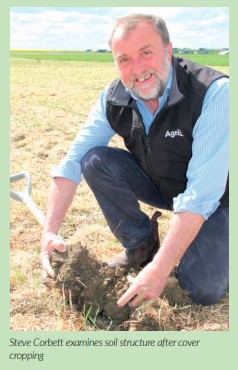
Putting Covers Into Context With Understanding
Cover and catch cropping may work well for many managing lighter and erosion-prone soils but for those on heavier and more difficult ground they remain very far from the answer to any sort of maiden’s prayer.
The right covers managed in the right way can help structure even the most challenging soils. However, in many cases they are unlikely to repay their investment in the medium term, if at all. They can also get in the way of both grassweed control and subsequent crop performance. This is clear from six years of field scale research involving more than 600 separate plots and detailed soil and crop record-keeping at Agrii’s Stow Longa Technology Centre near Huntingdon on the Cambridgeshire, Bedfordshire, Northamptonshire border.
“Cover cropping, in particular, makes a lot of sense and can be a valuable addition to the soil management tool box in some cases,” reflects trials manager, Steve Corbett who has been running the investigations on the silt-over-clay soil since 2014. “But our experience here is that biology alone is still not measuring-up to the performance we get from cultivations.

“Our work with growers across the country, indeed, suggests that over two-thirds of cover cropping may be a waste of time and money. On heavier land, in particular, it’s amazing how often the very soil problems people seek to address with the practice are the main reasons for its failure.
“More than anything else, we find the primary keys to success with cover or catch cropping are knowing what you want to achieve, then integrating the right approach effectively into the rotation to do so. “
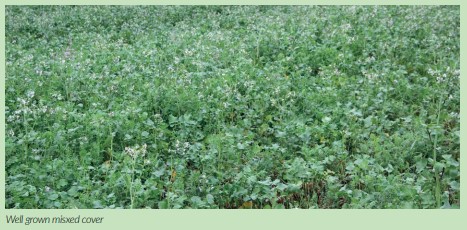
Aimed at understanding these critical building blocks, Agrii’s long-term Stow Longa studies are providing muchneeded clarity into the whole ‘metal vs roots’ debate. To date they have involved successive cereals – winter wheat followed by three spring barleys and two winter wheats – grown in adjacent 24m strips. Seven different establishment regimes have been maintained throughout – two employing varying degrees of cultivation, one with a straw rake and direct drill alone, and four with different catch and cover crops ahead of direct drilling. In margin over input and establishment cost terms, the cultivated strips continued to out-perform all other treatments in 2020. And, over the six years the ‘metal’ treatments show an average annual advantage of more than £125/ha over the ‘roots’.
“As catch crops are in the ground for such a short time, we would expect the best performance from roots to come with cover cropping ahead of spring barley,” reasons Mr Corbett. “But when we only look at the springcropping situations, the metal-overroots advantage remains an average of almost £120/ha/year.
“We see exactly the same thing across our rotational blackgrass management trials where we have maintained a dedicated catch/cover crop regime alongside both plough and deep one pass cultivation strategies since 2017. Roots simply aren’t matching the yields we get from cultivations on this soil type. The extra seed and sowing costs involved mean annual margins are well adrift. And blackgrass control is sadly lacking in many cases.”
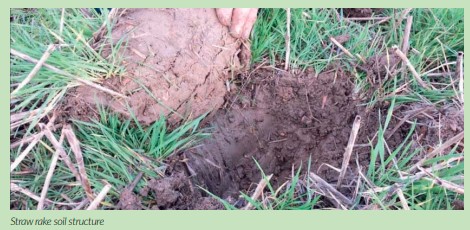
Despite the discouraging immediate economics, detailed soil investigations at Stow Longa are suggesting longer term benefits from catch and cover cropping that may be worth paying for.
The most recent broad spectrum soil analyses, for instance, show organic matter levels of up to 4.4% under some of the ‘root-only’ regimes against an average of 3.8% for the cultivated strips. Solvita testing also reveals noticeably higher microbial biomass levels, potentially mineralizable N contents and soil assessment scores here too. What’s more, advanced DNA sequencing at the Centre for Ecology and Hydrology (CEH) highlights clear differences in microbial communities between the areas, with several years of cover cropping associated with higher populations of potentially beneficial indicator micro-organisms and lower populations of potentially harmful ones than cultivations.
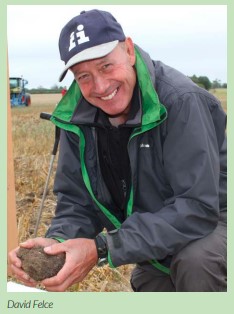
“It’s early days yet in our detailed investigations,” Mr Corbett insists. “However, both they and the obvious improvements in soil condition we have seen with the best covers are certainly encouraging. The CEH findings also underline the complex interactions that need to be understood if we are to best balance economics, grassweed control, soil structural improvement and carbon capture, to name but a few priorities.”
“Perhaps the most important practical lesson to come out of our studies here, on iFarms and with commercial growers across the country is that we have to see catch and cover cropping as parts of integrated soil management rather than means in themselves,” insists Agrii regional technical adviser, David Felce who works closely with Steve Corbett.
“Well-rooted covers will help hold a good soil structure over winter, increasing its resilience and supporting quality spring seedbed creation. On heavy land at least, though, we cannot expect them to correct soil structural failures. This means we have to get the fundamentals of drainage right in the first place. Nor must we be afraid of continuing to use metal strategically wherever it’s needed. Our challenge is to make sure roots and metal work together in soil management.
“Just like any small-seeded crop, setting the soil-up correctly ahead of a cover and putting it in with the best seed/soil/moisture contact is crucial for the effective establishment without which it cannot do any sort of job. It should also be seen as the first step in enabling the following cash crop to be drilled into a decent seedbed with minimum soil movement to preserve soil moisture and limit grassweed germination.
“Whether short or longer term, covers need to be carefully planned into the rotation,” he warns. “On most heavy ground an August-sown catch crop simply doesn’t have enough thermal time to do much, if any, good ahead of wheat sown in October. A summer cover on uncropped land or a catch crop after July-harvested forage rye, though, is a different story.
“Over-wintered covers ahead of spring crops clearly offer the greatest value. But even these need to be chosen carefully both for the job we want them to do and where they are in the rotation
“If drying the soil and improving its friability near the surface are the main priorities we find phacelia or mustard are some of the best bets, while for soil conditioning to a greater depth black oats or vetches are likely to be much better.
“Rotational care is equally important to avoid covers providing a green bridge for aphids, slugs, flea beetles or an array of diseases,” Mr Felce adds. “And in our experience, they need to be destroyed six weeks ahead of sowing to avoid compromising the performance of the next crop. Compared to this, drilling spring barley ‘on the green’ in our rotational trials at Stow Longa last season cost us an average of 0.5t/ha.”
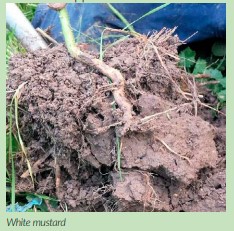
So what approach do Steve Corbet and David Felce suggest with catch and cover cropping, in general, and on heavy or difficult ground, in particular? Caution is their clear watchword; and they are adamant that everyone needs to set out with clear – and achievable – objectives, then plan and manage their covers to achieve it.
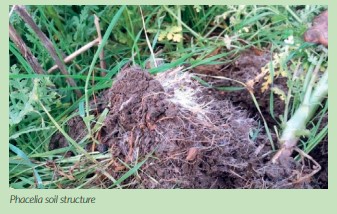
They warn against spreading resources too thinly across too large an area at the outset. Instead, they recommend focusing sufficient resource on a limited area of ground most likely to benefit initially; only moving ahead more widely on the basis of experience. Above all, they stress that soil improvement with biology can never be a quick fix so the rewards will only come with time.

“In their place, we see cover crops having the potential to play a valuable part in soil improvement efforts,” Mr Corbett concludes. “But we still don’t understand enough about the complexities of the biology involved to be sure exactly where this place is in many cases.
“We do know that what’s right for one situation may be completely wrong for another. The greater understanding of the essential cover and catch cropping building blocks we are achieving with our long-term work is essential if we are to put them together in the right way for the most consistent value.
“The financial penalties we continue to see at Stow Longa mean the immediate cost of replacing metal with roots as a key establishment tool across a large part of the country’s arable area is likely to be too great for many unless they can be sure of substantial long-term soil sustainability benefits.”
-
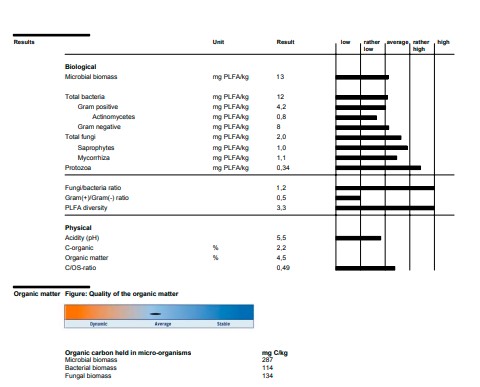
New Analysis Aims To Unlock Soil Health
Written by Dan Robinson from Eurofins
We have created new soil tests that will help farmers and agronomists understand their soil in a more detailed way than ever before. The tests have been launched in the UK and Ireland to provide chemical, physical, and biological insight, offering farmers a better way to monitor, manage and improve the health and fertility of their soil.
Three new products are now available to UK and Irish agriculture. Fertilisation Manager®, Soil Crop Monitor® and Soil Life Monitor® offer the most comprehensive way to analyse and improve soil health. Fertilisation Manager measures soil fertility. This includes the chemical values of macro and micronutrients. Soil pH and the overall structure of the soil is also analysed in conjunction with biological components such as fungi and bacteria.
The microbial biomass from the sample will help farmers to understand the sensitivity of the soil to conventional farming methods such as ploughing. The number and nature of the bacteria present in a soil sample will also facilitate the accurate calculation of what nutrients need to be added to the soil to optimise plant health and growth. Soil Crop Monitor will provide the most accurate means of testing soil during a growing season. Unlike some tests, Soil Crop Monitor analyses both the soil and the plant. This measures the plant available nutrients and the nutrients absorbed by the crop.
Soil Life Monitor
Soil Life Monitor determines the total microbial biomass, fungi, bacteria and protozoa. It also identifies some physical characteristics such as pH and the quality of organic matter. PLFA (phospholipid fatty acids) found in soil can be measured to provide a fingerprint of the soil content. PLFAs are degraded quickly in the soil, so the analysis gives an indication of the amount of living biomass. This is the most detailed routine analysis of soil life available and has countless applications for agriculture. We are therefore excited to make all of these tests available to farmers and growers across the UK and Ireland.
The details behind Soil Life Monitoring
The biological parameters are based on the phospholipid fatty acids (PLFAs) that are present. PLFAs occur in the cell walls of living organisms. Different functional groups have a unique composition of PLFAs. By measuring the composition of the PLFAs, a fingerprint of the microbial community can be given. The target values are corrected based on the organic matter percentage.
Total microbial biomass
The sum of all PLFAs is an indication of the amount of microbes. Because PLFAs are rapidly degraded after an organism dies, it mainly represents the living microbial biomass. The microbial biomass can be increased by adding effective organic matter such as compost, solid manure, green manures or cultivating grains (incl. straw). Other examples of measures are reduced soil tillage, permanently covering the soil, temporary grassland or less ploughing up of permanent grassland.
Total bacteria
Certain groups of bacteria break down (simple) organic material, fix nutrients, bind atmospheric nitrogen, convert ammonium into nitrate nitrogen, form stable aggregates, increase disease resistance and form breakdown products that can weaken or kill pathogens. Bacteria are stimulated by easily degradable materials with a low C/N ratio such as slurry.
Actinomycetes
Actinomycetes are a group of Gram(+) bacteria that form threads that resemble fungal hyphae and are able to break down complex materials. Actinomycetes are important for disease resistance, because some species can excrete antibiotics or parasitize pathogens. They can also compete with pathogenic fungi for space and food. Actinomycetes prefer airy conditions and develop poorly in compacted soil or acid conditions (pH <5).
Total fungi and saprophytes
Fungi cause degradation of complex forms of organic material, form stable aggregates, excrete organic acids which improve the availability of some nutrients and increase disease resistance through competition or predation. Fungi are stimulated by recalcitrant materials with a high C/N ratio such as straw and compost.
Mycorrhiza
Arbuscular mycorrhizas are a special group of fungi. They live in symbiosis with plant roots and thereby increase the root surface. In exchange for sugars, the plant receives water and nutrients such as phosphorus and potassium. Crops that are not able to form a symbiosis with arb. mycorrhiza are crucifers (e.g. cabbage and yellow mustard) and the goosefoot family (e.g. spinach and beet). A high available phosphate content will reduce the development of mycorrhizas.
Protozoa
Protozoa are single-cell micro-organisms that contain a cell nucleus (eukaryotes). The most important function of protozoa is to make nutrients available to the plant by “grazing” on microorganisms (mainly bacteria). The activity of protozoa is highly dependent on the presence of moisture in the soil. The radius of action of protozoa is limited to water films and water-filled pores.
Fungi/bacteria ratio
The fungi/bacteria ratio indicates the proportion between the fungal and bacterial biomass (expressed in mg C / kg). In general, undisturbed ecosystems have a higher fungi/bacteria ratio than disturbed systems. Organic and lowinput systems have a higher fungi/ bacteria ratio compared to enriched conventional systems. Disturbances such as tillage, removal of crop residues and grazing can lower the fungi/bacteria ratio.
Gram(-)/Gram(+) ratio
Grams(+) bacteria are generally larger than Gram(-) bacteria and can form spores. This makes them more resistant to drought and water stress. Gram(+) dominant populations (>1) are more common at the start of the growing season and typically move to a more balanced community when the soil conditions become more favorable throughout the growing season.
PLFA diversity
The PLFA diversity (Shannon index) is an indicator of the diversity of the soil life. However, the diversity of the PLFAs is not the same as the actual diversity because one unique phospholipid fatty acid does not represent one species. Higher diversity is often related to better stability and resilience. Disturbances, lack of diverse input from food sources and an intensive crop rotation can decrease the diversity.

Quality of the organic matter
Organic matter mainly consists of C, N, P and S. Dynamic organic matter contains relatively many N and S, and is easily broken down by microbes. Hereby, nutrients are mineralized that become available for the crop. Stable organic matter contains a relatively large amount of C, and is broken down less fast by microbes. Stable organic matter contributes, among other things, to the processability and looseness of the soil. The quality of the organic matter can be (gradually) adjusted by paying attention to the properties of organic materials (degradability and C/N ratio) such as animal manure, compost and crop residues.

Growing insight with soil and crop analyses
To provide insight into the functioning of the soil, Eurofins Agro distinguishes between the various fractions in which nutrients are present in the soil: direct available elements, plant available elements, (adsorbed) soil stock and total soil stock. Eurofins Agro supplies various analyses that provide insights into the nutrient reserve in the soil, the condition of the soil and uptake by the crop. The analysis report is always accompanied by crop and soil specific advice.
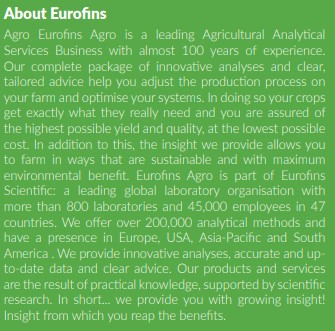
-
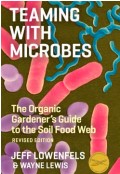
What Do You Read?
If you are like us, then you don’t know where to start when it comes to other reading apart from farming magazines.
However, there is so much information out there that can help us understand our businesses, farm better and
understand the position of non-farmers.We have listed a few more books you might find interesting, challenge the way you currently think and help you farm better.
Teaming with Microbes: The Organic Gardener’s Guide to the Soil Food Web

Smart gardeners know that soil is anything but an inert substance. Healthy soil is teeming with life not just earthworms and insects, but a staggering multitude of bacteria, fungi, and other microorganisms. When we use chemical fertilizers, we injure the microbial life that sustains healthy plants, and thus become increasingly dependent on an arsenal of artificial, often toxic, substances. But there is an alternative to this vicious cycle. We can garden in a way that strengthens the soil food web the complex world of soil-dwelling organisms whose interactions create a nurturing environment for plants. “Teaming with Microbes” extols the benefits of cultivating the soil food web. First, it clearly explains the activities and organisms that make up the web.
Next, it explains how gardeners can cultivate the life of the soil through the use of compost, mulches, and compost tea. The revised edition updates the original text and includes two completely new chapters on mycorrhizae (beneficial associations fungi form with green-leaved plants) and archaea (single-celled organisms once thought to be allied to bacteria). With Jeff Lowenfels’ help, everyone from devotees of organic gardening techniques to weekend gardeners who simply want to grow healthy, vigorous plants without resorting to chemicals can create rich, nurturing, living soil.
The Omnivore’s Dilemma: A Natural History of Four Meals

For the past twenty years, Michael Pollan has been writing about the places where the human and natural worlds intersect: food, agriculture, gardens, drugs, and architecture. His book The Omnivore’s Dilemma, about the ethics and ecology of eating, was named one of the ten best books of 2006 by the New York Times and the Washington Post. He is also the author of In Defence of Food, The Botany of Desire, A Place of My Own and Second Nature, and the upcoming Food Rules: An Eater’s Manual.
The Hidden Half of Nature: The Microbial Roots of Life and Health

The Hidden Half of Nature lays out the astonishing reality we’ve been missing in the soil beneath our feet and right inside our bodiesour world depends on a foundation of invisible life. Montgomery and Bikle share a captivating story of the least-loved part of nature, taking readers through major milestones in agriculture and medicine to untangle our uneasy relationship with microbes. From the challenge of turning their barren Seattle lot into a flourishing garden through Bikle’s struggle with a surprise cancer diagnosis, the authors discover the power nature’s smallest creatures wield over our lives. Stunning parallels in the relationships that microbes develop with plant roots and the human gut reveal ways that farmers can restore degraded fields and doctors can reverse the modern epidemic of chronic diseases. For in cultivating the beneficial microbes that make soil fertile and keep us healthy, we can suture rifts never meant to be.
The Diet Myth: The Real Science Behind What We Eat

Why do most diets fail? Why does one person eat a certain meal and gain weight, while another eating the same meal loses pounds? Why, despite all the advice about what to eat, are we all still getting fatter? The answers are much more surprising – and fascinating – than we’ve been led to believe. The key to health and weight loss lies not in the latest fad diet, nor even in the simple mantra of ‘eat less, exercise more’, but in the microbes already inside us. Drawing on the latest science and his own pioneering research, Professor Tim Spector demystifies the common misconceptions about fat, calories, vitamins and nutrients. Only by understanding what makes our own personal microbes tick can we overcome the confusion of modern nutrition, and achieve a healthy gut and a healthy body.
Small Is Beautiful: A Study of Economics as if People Mattered
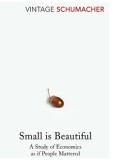
How does our economic system impact the way we live? Does it really affect what we truly care about? Oxford economist E. F. Schumacher provides an enlightening study of our economic system and its purpose, challenging the current state of excessive consumption in our society. Offering a crucial message for the modern world struggling to balance economic growth with the human costs of globalisation, Small Is Beautiful puts forward the revolutionary yet viable case for building our economies around the needs of communities, not corporations.
Food in History
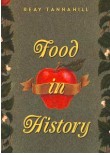
An enthralling world history of food from prehistoric times to the present. A favorite of gastronomes and history buffs alike, Food in History is packed with intriguing information, lore, and startling insights– like what cinnamon had to do with the discovery of America, and how food has influenced population growth and urban expansion.
The Englishman’s Food: Five Centuries of English Diet
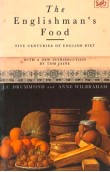
Medieval gardens; cookshops; spices; ale, beer, wine and spirits; the food of peasants, labourers, townspeople, the wealthy, the poor and the country gentleman; fish, meat and game; the feeding of infants, children; dairy products; vitamins, proteins, fat and fibre; the adulteration of food; the four bottle man; bread; poaching; tea, coffee and chocolate; food in schools and institutions; sugar and sweetmeats; root crops; the agricultural revolution; the importance of ‘white meats’, the vegetarian diet; menus and recipes. . . The Englishman’s Food was first published in 1939, fully revised in 1957 and now appears with a new updating introduction. A ground-breaking book, it is a fascinating and authoritative survey of food production, consumption, fashions and follies over a period of five hundred years. Reprinted with a new introduction by food editor Tom Jaine.
Green and Prosperous Land: A Blueprint for Rescuing the British Countryside

News about Britain’s wildlife and ecosystems tends to be grim. In Green and Prosperous Land, Oxford economist and Natural Capital Committee chair Dieter Helm shares his radical but tangible plan for positive change. This pragmatic approach to environmentalism includes a summary of Britain’s green assets, a look towards possible futures and an achievable 25- year plan for a green and prosperous country. The bold generational plan assesses the environment as a whole, explains the necessity of protecting and enhancing our green spaces and offers a clear, financially sound strategy to put Britain on a greener path. Helm’s arguments expose the economic inefficiencies in our environmental policies and thus highlight the need for change. Leaving behind the current sterile and ineffective battle between the environment and the economy, this revolutionary plan champions the integration of the economy and the environment together to deliver sustainable, eco-friendly economic growth. There is hope, and there is time, but we must act now.
-
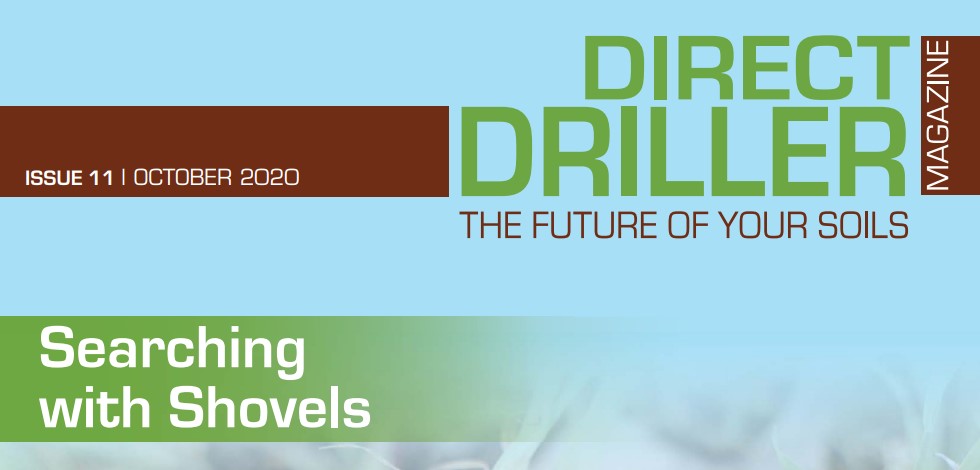
Introduction – Issue 11
Welcome to another 100 pages of Direct Driller magazine. Pages that tell farmers so much about the mysteries of soil and the ways ingenious engineers and scientists have devised to handle it. This story has only recently become news. In recent years the world of media, politics and education have begun to grasp the story, but often in a negative way.
The headlines are about the final harvest being just 60, or is it 100, years from now. Farm chemicals polluting waterways; insecticides wiping out whole species of insects… we’re all too familiar with the stories. In a recent BBC broadcast Tony Juniper, chair of Natural England, echoed Sir David Attenborough’s evidence of unfolding global catastrophe, and agriculture was at the top of his list of ills which are reducing the population of the natural world of insects, plants, birds and animals.
The world, quite rightly, nods in agreement but does little more, continuing to buy fresh peas from Zimbabwe when the same crop was growing here in the UK. I wrote to him (no reply, naturally) saying that it was wrong to tar the industry with one brush. I reminded him that agriculture is highly diverse, ranging from the total sterility of poly tunnels to the improving habitat from cover cropping and No-till. I explained that farming is making giant strides in accommodating the natural world into their production systems, not to appease the campaigners but because it actually makes long term economic sense.
The world of microbes is being harnessed to help, and crop protection is changing out of all recognition as farmers learn to love the insects they had been brainwashed to hate. The inveterate old codger Dan Archer – “it’s all in the soil” – might have been onto something all those years ago, but his message was villified by all involved in modern agriculture.
Is his message being told on farms in Africa and other developing parts of the world?
Certainly no evidence when I visited Zambia, where centre pivot irrigation, ploughs and cultivators is the modern way of farming. What a shame it is that people with real influence can only think negatively. Imagine the results if the converse were true. Sir David telling his global audience how farming techniques are not set in stone, and modern farmers can and are working with rather than against nature. How the techniques of creating soil biomass are getting amazing results.
Where all that green waste which the world now takes to the recycling centre (dump) ends up. Stories that are positive for both the natural world and farming itself. Publicity which converts into funds for research, for knowledge exchange, globally. It’s a real honour to edit a magazine which does just this. I know that readers will be fascinated by the contents of this issue. The mixture of science, engineering, ethics and, of-course, the invaluable Farmer Focus articles.
Reading how farmers have coped with the savage season that was 2020, and what changes they have planned as a consequence are always interesting. Finally, a quick reminder that I am available to take on speaking engagements over the upcoming winter season.



-

The Problem with Information
As farmers, information is becoming very important to us. However, the ability to move information from one place to another is never easy. Thus, every platform we use requires us to add the information all over again. It’s something I point out to companies a lot, “that’s a great idea, but asking the farmer to enter that information all over again manually won’t be popular”.
The big question is why can’t information transfer be standardised?
The simple answer is of course, it can. At the moment we don’t have an ISOBUS standard for information – but it would be really useful and I do think it will happen. Afterall, it is your information, so you should be able to export it from any system and import it into another. We are just as guilty of this as every other company, it is something we have recognised and are trying to fix.
Our latest development project is called Farm Compare. It will allow farmers to share anonymised and rounded prices for crop protection products for free. It’s a great example of how to share information to gain business intelligence. Answers are immediate and the more farmers that use it, the more powerful it will be. You will be able to compare one buying group against another and even in the future compare whether serviced or supply would be best for your business.
However, you will do all this using your anonymous The Farming Forum username. No need to create another account to access another service. We are also talking to the crop management software companies to allow you to export the prices out of their systems and into Farm Compare. We have also recognised that it isn’t easy to manage your Direct Driller subscription. The plan over the next few months to incorporate your subscription preferences in with your TFF membership.
So that you can update your own address and whether you would like to receive the magazine in print or digitally. At this point, one username and password will give access to Direct Driller subscription, The Farming Forum and Farm Compare. A very small step forward in trying to make all your lives a little easier.

https://thefarmingforum.co.uk/index.php?farm-compare/ 

-

Featured Farmer – Martin Lines
PAPLEY GROVE FARM, ST NEOTS, CAMBRIDGESHIRE

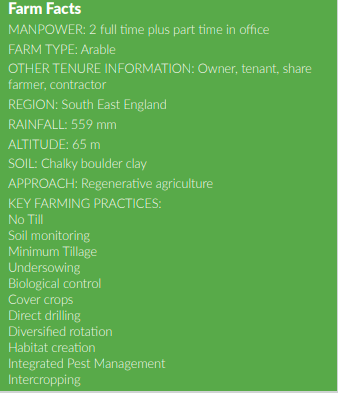
I am a third-generation farmer and contractor and grow mainly arable crops on the family farm and rented land. The farm is just over 400 acres. Our rented land and contract farm agreements bring the farm area up to 1334 acres.
We mainly do combinable cropping growing commodity crops of winter wheat, winter and spring barley, winter beans and oil seed rape (OSR). We always try and find a human food home for the products or, as with beans, they go to an animal feed home to replace imported feed.
I am Chair of the Nature Friendly Farming Network (NFFN) and have a particular interest in farm conservation management. I am currently running an ELS and HLS agreement on the home farm and Countryside Stewardship schemes on land I rent. For over 10 years our farm was in the old Countryside Stewardship Scheme to try to improve the natural habitat for wildlife on the farm. We replaced many hedges around the fields which had been removed, improved the few that were remaining and planted new ones. We also established grass strips alongside hedges and ditches and on our field boundaries. Over this time, we saw a significant increase in both flora and fauna on the farm. RSPB volunteers undertook several surveys which identified a wide range of species, including birds of high conservation concern such as turtle doves, yellow wagtails and corn buntings.
In the last 8 years we have been in both an ELS and an HLS scheme, planting areas of wild bird seed mixes and creating wildflower areas (see the two videos below) and flower enhanced boundary strips, as well as leaving an area of fallow land as a food and nesting source.
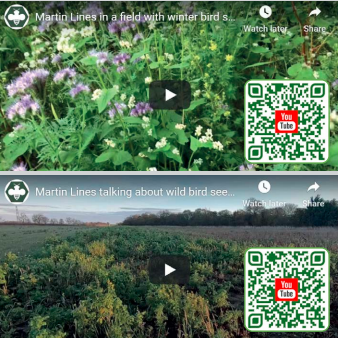
We have over 40 skylark plots distributed throughout our fields (see video footage below) and continue to sympathetically manage our old ridge and furrow meadows.
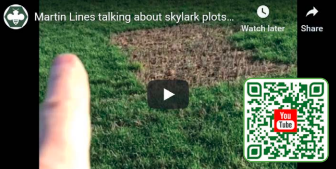
I hope to continue and extend our conservation work and link up wildlife habitats on neighbouring farms. We have made many wildlife corridors across the farm to help the wildlife move about. Other nature friendly farming practices we carry out on the farm are following an integrated pest management (IPM) approach, using chicken manure to help improve soil and replace artificial fertiliser, and cover cropping and direct drilling. We have started to bring in sheep to graze cover crops in the winter and are trying to use a crimper to kill cover crops.
Talking to other like-minded farmers as part of the NFFN has given the opportunity to share best practice and understand that the best way we can farm is farming with our environment around us. Watch the video below to hear me describe what I have done on the farm to attract wildlife and my message to farmers who may be interested in joining the NFFN.

Sustainability in Practice:
Direct drilling, cover cropping and crimping
I moved from a plough-based system to using a machine that moved the soil I wanted to a depth I wanted, allowing us to treat fields with compaction or soil health problems differently. I now try and work with our soils with the understanding that doing less is better. My soil is my asset – it’s where I get my production from. I grow cover crop mixes including buckwheat, phacelia, sunflower, vetch, linseed, fodder radish and crimson clover, to benefit the soil health, produce and grow nutrients, harvest the sunlight and turn it into organic material to help increase our soil organic content.
I have started using a drill with a crimp roller on the front – which allows us to grow big cover crops and be able to manage them. We are looking at establishing which cover crops work for us and different lengths of growing season. The crimp roller lays the crops down, creating a mat which suppresses weeds (see the video footage below).

The machine I have been using also allows us to use different seed mixes according to the area, so in compacted zones we can put in a different crop mix and target those areas. We can also intercrop rows. In addition to improving our soil health and reducing compaction, the low soil disturbance due to cover crops and direct drilling has led to more insect life in the fields – predators are building up and managing most of our pest problems, allowing us to reduce our operation and input costs. This video explains the machinery I’ve been using and benefits I’ve noticed in a bit more detail:
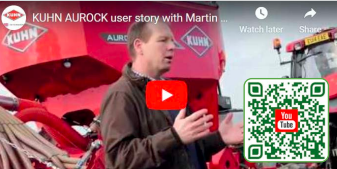
Nature based IPM
About 7 years ago I decided to do what I could to control pests without insecticides and monitor the impacts on my yields and profit margins. There is no blueprint to IPM – it has to be a whole farm and landscape approach, it is not as easy as conventional farming with pesticides. Many measures I have adopted in the transition to regenerative agriculture have multiple benefits. I have broadened the range of crops I grow; moving from a system of 2 wheats, OSR, 1 or 2 wheats, and beans, all wintersown, and a ratio of crops in the ground of roughly 70% wheat, 20% OSR, 10% beans, to now having winter and spring barley and no fixed rotation, and tailoring the cropping in each field to help with weed pressure and soil health. If I have a black-grass problem I will not go with a second wheat, even though this may give a better return than a spring or break crop. Crops in the ground now are about 40% wheat, 30% barley, 20% beans and 10% OSR. This would seem like a less profitable rotation, but I have slashed my cost of production (which has made up for any reduction of yields and crop values) and my net profits have increased.
I use pest resistant varieties where possible and have moved back to traditional recommended cropping intervals – with 5-6 years between OSR crops. I drill cereals after mid-October if weather allows, rather than September to reduce black-grass and autumn aphid pressure. I avoid over-feeding crops with nitrogen fertiliser in one application to prevent rapid growth, making the crop more prone to pest and disease pressure.
Creating habitats to enable beneficial insects and spiders to thrive is key. In addition to flower-rich margins around the outside of the fields (see the video footage below), I’ve been adding flower-rich strips every fourth tramline (120m) to improve natural pest control and insect pollination.
I see the benefits of in-field strips on the yield maps of my OSR and beans; yields are 5-20% greater next to the strip and tail off further into the field. This also reflects my observation of the number of bumblebees I see across the fields. The yield response is probably a combination of the effects of increased insect pollination and increased natural pest control.
Improved soil health, crop health and better rotations have also enabled me to cut down on my use of herbicides, fungicides and molluscicides. I monitor slug levels, but if I see lots of beetles in the field, I see if they can do the job first and only treat areas that seem to be struggling.
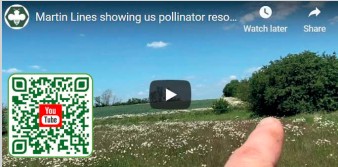
I have been trying a few ideas this last year to further benefit from the IPM approach – I’ve sown a mix of wheat varieties in my wheat field to avoid pest and disease risks that can arise from a single variety monoculture, have undersown beans with clovers, and tried intercropping oilseed rape with phacelia and clovers to see if these measures will disguise the crop from pests and boost beneficial numbers further. Overall, crop yields are a little lower, but this is more than made up for by the reduction in costs of production and the net margins are up, despite reducing the areas of wheat, our most profitable crop.
There are visibly more beneficial insects and spiders and more wildlife overall, especially birds. The incidence of pest levels exceeding economic thresholds has declined to zero. You can find this information in the Farm Wildlife case study on Agricology, which also gives more detail on what led me to transition towards not using insecticides and the environmental and cost impacts of that and of reducing herbicides, fungicides and molluscicides and applying the other regenerative agriculture techniques I describe.
Motivations:
I joined the NFFN because I believe that safeguarding the future of our countryside and the wildlife that resides in it is imperative and the way that we produce food in the UK and the rest of the world needs to radically change. Healthy soil and a healthy environment are essential to long-term food production. If we do not deliver a healthy environment, the next generation will not have reliable food production. Unless we join up environmental improvements, climate mitigation and biodiversity delivery alongside production of food in the landscape, we cannot guarantee the long-term availability of food. A national shift to nature friendly farming is one of the only ways we can guarantee long-term food production.
The diversity of the British countryside is an asset that is vital to wildlife and of great value to the general public. The right support is crucial to the continuation of work done by many farmers and landowners to improve the habitats for wildlife. I believe that by working together, we can enhance and improve our countryside for all to benefit, but we need the right policies and support in place to help us fulfil the potential that farmland has for conservation.
Read more about my thoughts on the value of the NFFN and what it offers to the industry on the NFFN website..
Listen to Martin talking about his farm and the story behind the NFFN in this ‘Meet the Farmers’ podcast published in January 2019:

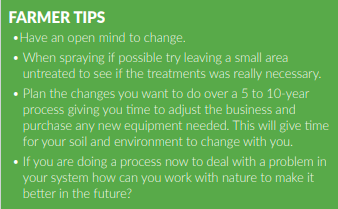
The video footage below is an example of trying to safeguard the future of some of our wildlife – using herbicides to selectively target weeds and protect lapwing nesting in a field of winter beans.
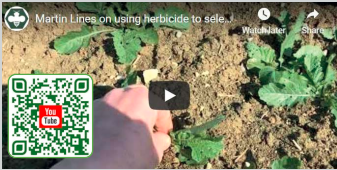
All photos courtesy of Martin Lines.
All Rights Reserved Visit www.agricology.co.uk to view this profile in full. Agricology is an independent collaboration of over 40 of the UK’s leading farming organisations sharing ideas on sustainable farming practices. We feature farmers working with natural processes to enhance their farming system, and have a wide range of farmer videos on our YouTube page. We also share the latest scientific learnings on agroecology with the farming community from our network of researchers. Our website hosts over 400 articles on different agroecological practices. In response to social distancing we are hosting a series of online virtual field days on a range of agroecological practices in collaboration with our partners. Subscribe to the newsletter or follow us on social media @agricology to keep up to date and share your questions and experiences with the Agricology community
-

Global Study Reveals Time Running Out For Many Soils – But Conservation Measures Can Help
Written by Lancaster University, UK


A major new international study has provided a first worldwide insight into how soil erosion may
be affecting the longevity of our soils.The study, led by Lancaster University in collaboration with researchers from Chang’an University in China, and KU Leuven in Belgium, brought together soil erosion data from around the globe, spanning 255 locations across 38 countries on six continents. This data was used to calculate how long it would take for the top 30 cm of soil to erode at each location – the soil lifespan. The top layer of soil is often rich in nutrients and organic matter, making it important for growing food, fibres, feed and fuel. Soil erosion is a serious threat to global sustainability, endangering food security, driving desertification and biodiversity loss, and degrading ecosystems The study included soils that are conventionally farmed, as well as those managed using soil conservation techniques, to find out how changes to land use and management practices can extend the lifespans of soils.
Researchers found more than 90 per cent of the conventionally farmed soils in the study were thinning, and 16 per cent had lifespans of less than a century. These rapidly thinning soils were found all over the world, including countries such as Australia, China, the UK, and the USA.
“Our soils are critically important and we rely on them in many ways, not least to grow our food”, says lead author Dr Dan Evans of Lancaster University. “There have been many headlines in recent years suggesting that the world’s topsoil could be gone in 60 years, but these claims have not been supported with evidence. This study provides the first evidence-backed, globally relevant estimates of soil lifespans.
“Our study shows that soil erosion is a critical threat to global soil sustainability, and we need urgent action to prevent further rapid loss of soils and their delivery of vital ecosystem services.”
However, there are causes for optimism. In the data, soils managed with conservation strategies tended to have longer lifespans, and in some cases these practices promoted soil thickening. Only seven per cent of soil under conservation management had lifespans shorter than a century, and nearly half exceeded 5,000 years. Co-author, Professor Jess Davies, also of Lancaster University, said: “Whilst 16 per cent of soils with lifespans shorter than 100 years is a more optimistic estimate than ‘60 harvests left’, soil is a precious resource and we can’t afford to lose that much over a human lifetime.
“But importantly what our study also shows is that we have the tools and practices to make a difference – employing the appropriate conservation methods in the right place can really help protect and enhance our soil resource and the future of food and farming.”
Converting arable land to forest was found to be the best way to lengthen soil lifespans. However, other approaches that allow farming to continue, such as cover cropping, where plants are grown between cropping seasons to protect the soil, were also shown to be highly effective. The ploughing of land along contours rather than down slope, and hillslope terracing were similarly suggested as beneficial for lengthening soil lifespans.
Professor John Quinton, of Lancaster University and co-author of the study, said: “It is clear that we have a conservation toolbox that can slow erosion and even grow soil. Action is needed to promote the adoption of these measures so that we can protect and enhance our soil resource for future generations.” The study is detailed in the paper ‘Soil lifespans and how they can be extended by land use and management change’, published in the journal Environmental Research Letters.
The paper’s authors are Dr. Daniel Evans, Professor John Quinton, and Professor Jessica Davies of Lancaster University, Dr. Jianlin Zhao of Chang’an University in China, and Professor Gerard Govers of KU Leuven in Belgium.
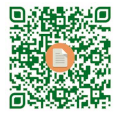
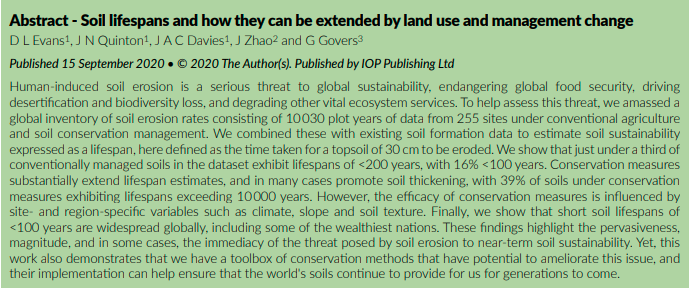
-
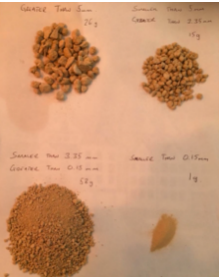
Agricultural Lime – Calcium Carbonate
Written by James Warne from Soil First Farming
“I don’t care what colour it is, what it looks like or it’s consistency, it’s lime, get it spread” were words quoted to me recently by an agronomist who clearly didn’t understand the basics of some simple chemistry. The above quote was part of a conversation about the quality of liming material and in particular the particle size of lime delivered to farms in the UK. I was being accused of overcomplicating liming by requesting that ‘Ground limestone’ should be specified and should be tested to make sure the product meets the specification. My point being any lime particle larger than 0.6mm (600 microns) is not going to effectively neutralise an acid pH.
This little nugget of useful information is clearly stated on the Agricultural Lime Association website (www. aglime.org.uk). For greater clarity and understanding 0.6mm is about the same size as the full stop at the end of this sentence. Not all lime is equal, and certainly our experience is that there is a lot of mis-selling going on in the ag-lime supply trade. A few years ago we were so dismayed by the quality of some of the bulk lime products being delivered to farms that we invested in a set of laboratory quality certified sieves to test our theory. To date we have tested many samples of lime and have yet to meet one which meets the statutory requirements of the Fertiliser Regulations 1991.

Below is one of the worst samples we found to date. To the many reading this I suspect this looks like the lime you are regularly sold, but in reality it’s total rubbish. Read on to find out why. In case you can’t read the handwritten notes in the photo, they are as follows; Top left; larger than 5mm 26% (should be zero %) Top right; smaller than 5m, larger than 3.35mm 15% (should be maximum 5%) Bottom left; smaller than 3.35mm, larger than 150 microns 58% (should be ~5%) Bottom right; smaller than 150 microns 1% (should be minimum 40%)
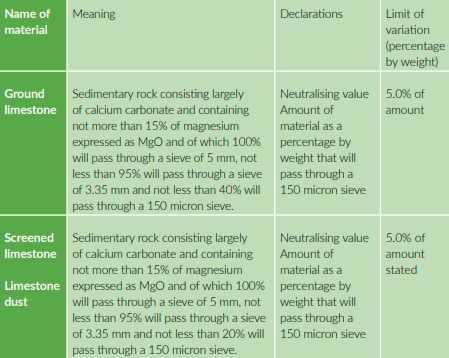
All ag-lime sold in the UK must meet the requirements of the Fertiliser Regulations 1991 to be sold as lime, for the purposes of this article I will look at limestone only, but these regulations also apply to dolomitic limestone, chalk and many other types of lime. The table below is taken from the Fertiliser Regulations. Using the detail in the table above we can see that the lime in the photo above fails on the following;
• Only 74% has passed the 5 mm sieve, where it should be 100%.
• Only 59% has passed a 3.35 mm sieve, where it should be at least 95%
• Only 1 % has passed the 150 micron sieve, where it should be at least 40% if declared ‘Ground’
Why does this matter, after all if ‘it looks like lime and smells like lime’ it must be okay surely?! My agronomist or lime supplier can’t be wrong, can they?
Sadly, yes they can and this seems to be going on around the country as far as we can tell. Why is this important? Getting soil pH and soil calcium levels at the desired levels is fundamental to all cropping, whether arable or grassland, vegetable, fruit, flower or viticulture production. Once the levels start to decline the effectiveness of inputs also starts to decline and the return on investment declines alongside. The health of the crop suffers which results in an increase in inputs which are already under pressure. You can see this becomes an ever-decreasing circle of increased cost and decreasing output.
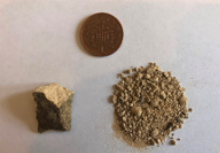
Focus on the detail of the basics and the output and profitability will follow. In order to substantiate the claims above please read on to discover the fundamentals of why and how lime works to ensure you are spending your hard-earned cash wisely.
Neutralising value
NV is a figure given to the potential of a lime to neutralise the free hydrogen within the soil. The figure is based upon pure Calcium carbonate equivalence. A high-quality limestone will have an NV of 55. As stated above this is the potential of the product to neutralise the hydrogen ions in the soil solution which cause acidity. To give this some perspective consider the photograph below. This is oolitic Cotswold limestone as found in my garden and sold from many local quarries as a liming material.
Both the lump of rock and the ‘crushed’ pile are derived from the same piece of rock. I simply smashed a larger piece of rock with a hammer a few times to achieve the ‘crushed’ sample. Both of these samples, the lump of rock and hammer produced ‘crushed’ sample will have an identical NV. If lab tested I suspect it would have an NV of ~50. So which one is going to be more effective at neutralising acid pH soil? If the only information given to you by the lime supplier is NV, you could receive lime like that on the left, or on the right. NV is only part of the story.
So, taking the example above the ‘crushed’ sample on the right will work faster at reducing the soil pH because it has a much larger surface area and is therefore more reactive. The piece of rock on the left will do very little, if any, neutralising in a time scale that matters to you. The timescale for good neutralising is weeks to months if the lime is correctly ground, or years to decades, if larger than 0.6 mm.
Grind size
As mentioned above we now know that grind size is as important as neutralising value in determining whether the lime will actually do as intended. This is where the fertiliser Regulations 1991 become relevant because they set out the standards for lime quality as a fertiliser. If we consider these regulations for a moment it is clear that both the neutralising value and the specific material name must be given, in addition the percentage by weight passing through a 150 micron sieve must also be declared (the grind size). A limit of variation (tolerence) of 5% is allowed.
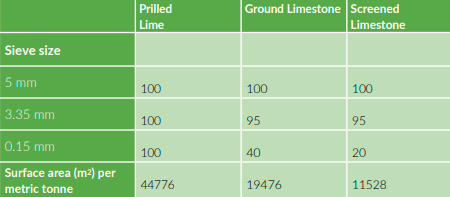
By grinding the rock finer we are increasing the surface area of the product. It is this increase in surface area which allows the lime to react faster and bring about quick reductions in soil acidity. If we calculate the degree of grinding and surface area we can see from the table below that ground limestone has a surface area nearly twice that of screened limestone, while prilled lime products can be four times the surface area of screened limstone. This increase will give greater reaction and therefore faster pH reduction.
So how fine does the rock need to be ground to be effective? The aglime website states that “coarser material requires a heavier application” and that “There is a considerable reduction in the effectiveness of liming materials containing particles above 600 microns (0.60mm, 60 mesh) unless the material is easily broken down”
This is supported by work taken from North Carolina University in the US shown top right;

This graph clearly demonstrates that lime in the range of 0.177 – 0.150mm (177-150 micron or 80-100 mesh) gave the quickest pH rise and most sustained pH rise. The larger particle size 0.841mm and above gave a very limited pH increase and took 18 months to achieve it.
Another response I have had is “I have been using the same products for years and never found a problem”. There are two responses to this proposition;
1, you have been using a good quality product all along; or
2, soil pH testing generally occurs every 4-5 yrs in line with regular soil analysis. Suppose that your soil testing shows a pH of 5.9 and you decide to apply lime in accordance with the recommendations, this will be around 8 tonnes/ha for a medium soil (RB209). But the product you use is of low quality and does not meet the specification. This will have little effect in raising the soil pH but you don’t go back to test again for another 4 yrs. This time around the soil test is registering around pH 5.8. You are almost expecting this as we are programmed to expect the pH to be low after 4 yrs of no lime so you go through the same routine again and again. But if you had used good quality ground limestone you may find that the pH has not dropped so far and therefore less is needed.
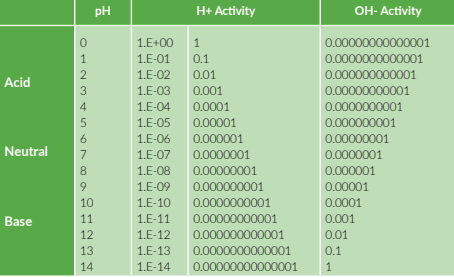
You may also find that output increases while your inputs decrease as crop health improves. But why doesn’t the pH drop lower 4 years after an application of low-quality lime? pH is a logarithmic scale which mean that each point difference in pH the hydrogen ion concentration changes ten-fold as shown in the table below. Therefore the number of hydrogen ions that need to be neutralised by the lime increases ten-fold for each unit drop in pH.
Cost comparison
If a routine application of granulated limestone extended to 200kg/ha/yr of product. Product cost is £125.00 tonne, the product cost is £25.00/ha plus a farmers spreading cost of £7.00/ ha. Total cost £32.00/ha To get an equivalent amount of useful lime from the sample shown at the beginning of this article assuming 10% fits through a 0.6mm sieve would require 2 tonnes/ha of aglime. Assuming a cost of £25.00/tonne delivered and spread. The total cost would be £50.00/ha.
The way forward
I am not saying don’t use lime, quite the contrary, lime is essential where required, but pay special attention to the quality if buying ground limestone. There is a downside to using good quality ground limestone and that is watching your neighbours benefit from your investment if your lime spreader turns up on a windy day. For the most cost-effective lime applications I suggest regular (annual or bi-annual) small applications of a granulated lime. You can apply it yourself with your own machinery, it’s 95% finely ground lime, and best of all, every penny that you spend on it will work for you.
-
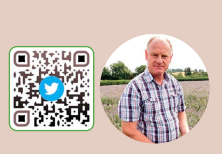
Farmer Focus – Simon Cowell
I have always found that pioneering a different system of farming is a lonely task, there is lot of contradicting advice out there but ultimately you have to make the decisions yourself.

I have read stacks of books on soil biology and regenerative agriculture and follow all the latest ideas from around the world, but I have increasingly found that a lot of information is not evidence based and relies on wishful thinking. Additionally, I receive advice on what I should be doing and what other farmers are doing from a conventional agronomist who is tied to a chemical distribution company, but this seems to be working on the same principal as paying life insurance premiums just in case the crop is going to die next week. Being exposed to vast amounts of diverging concepts and ideas makes decision making challenging.
For example, whether or not to use a fungicide on my wheat this year has been a difficult decision that had to be made several times during the growing season. The agronomist began by finding the first signs of yellow rust on several leaves – conventionally, a hefty fungicide would be used to kill off the disease and protect the rest of the crop. However, I had to balance this option with a wealth of unsubstantiated ideas that I have picked up over the years – fungicides damage soil life and interfere with photosynthesis, thus reducing plant sap sugar levels and increasing susceptibility to disease later on.
Furthermore, after years of biological farming, I consider my soil to be somewhat “disease suppressive”, meaning that the crops ought to be capable of fighting off disease themselves.
My crops came out of the winter in poor condition from standing in water for five months and with the onset of drought, I was expecting lower than normal yields, meaning costs had to be saved wherever possible. All these variables meant that deciding what to do with my wheat relied upon gut feeling and guess work; being a risk-taker and optimist, I applied very few fungicides this year and the yellow rust disappeared. I can only assume that the plants’ natural defences may have protected the wheat from yellow rust. Therefore, despite the benefit of hindsight, I am still unsure if these chemicals would have paid for themselves in a low yielding year or not.
The decision of whether or not to apply nitrogen this year was also tricky. The first two splits of three went on as usual, but then drought set in and it became obvious that the last application would never get washed in and become available to the crop. Tissue tests showed that there was plenty of nitrogen in the plants, so I was presented with another opportunity to save money on what was obviously going to be a lower yielding crop.
Typically, when I can’t resolve a dilemma, I experiment and hope to learn for the future; so with my gut feeling saying that it would be a waste of time and money to apply the last nitrogen, I put the last dose nitrogen on only one field and left the rest. Unfortunately, this did not teach me anything because although yields were quite variable, there was no correlation with nitrogen rates at all. In fact, in one trial, a strip with no nitrogen out yielded the half rate strip, and the rest of the field which had the full rate of nitrogen. My only conclusion is that the wet winter and spring drought had an overriding effect on yields, and there was nothing that could change them, whatever was applied.
It is generally recognised that building a natural soil structure by increasing organic matter and not cultivating will enhance the soil’s capacity for holding water.
High levels of mycorrhizae are supposed to improve water scavenging and roots should go deeper when not encountering cultivation layers. Unfortunately, I have yet to see any difference between my farm and any others around the area. There is a possibility that it works on light land, but on clay I have not found this to be the case. It seems to me that as clay shrinks through the course of drying, it allows more air into the soil which dries it out further. This drying puts the soil biology into hibernation, a real problem when you are hoping that this biology is going to do the work of fertilisers and chemicals.
I think that the more we rely on natural systems, the more vulnerable we are to weather extremes, sort of the opposite to hydroponic farming where everything is controlled so that the outcome is guaranteed. Conventional high input farming would be somewhere in between, still vulnerable to the weather but the nutrition being taken care of to a large extent by mineralisation from cultivations. There is also the fact that building soil organic matter levels requires nutrients, it is a biological process in direct competition with the growing crop. Unfortunately the bugs eat first, so there is very little left for plants when natural availability is limited by very dry conditions.
Like many farmers in the UK, I have not had a very good harvest. Winter crops were disappointing; however, some spring crops have done reasonably well considering the conditions they endured. With cost savings in so many areas of my business there is little stress on me when growing conditions are less than ideal. All farming has it’s up and downs, but if we are able to step back and look for answers, progress will continue to be made.
-
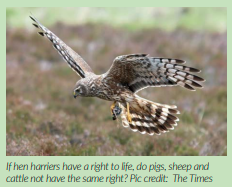
Agricultural Ethics: Charting The Path To A Sustainable Future
By Ralph Early (ralph@theethicalfoodie.co.uk)
Part one of this two-part article on agricultural ethics set out a thesis which argued that the development of farming as
an industrial activity during the 20th century, aided particularly by dynamic and commercially advantageous sciences and technologies, has brought us to a point where agriculture itself now presents a substantial threat to the natural world.
This is indisputable.The UK’s State of Nature partnership’s 2016 report cites, for instance, that farmland birds have declined by 54% since 1970, while butterflies as an indicator of the wider countryside have declined by 41% since 1976. Sadly, many species of wild plants and animals indigenous to the UK have been subject to extirpation as a consequence of various farming and land management practices over the last century, while some of the country’s most iconic wildlife is threatened by extinction. People, like wildlife, need the land.
The health of the land as a resource for human food production, and the linked capacity for wildlife to flourish, depends on an abundance of biodiversity: the biomass necessary for nature’s ecological processes to function properly in maintaining the vigour of the land and nature itself. Isabella Tree comments in her book, Wilding, saying that Britain is “among the most naturedepleted countries in the world”.
It seems that Britain is on a path which risks possible ecological collapse, threatening the very food systems that support both people and wildlife. It is clear that if we do not rethink farming – and, it has to be said, urban planning which is increasingly defined by avaricious motives and corrupt Westminster politics – we may reach a tipping point where, for example, seemingly inexorable environmental decline and the loss of keystone species brings down the increasingly fragile house of cards that is our country, our wildlife heritage and our home. It is, after all, our choice.

Farmers are members of the moral community. They are moral agents. They have the capacity to understand moral concepts and to distinguish what is morally right from what is morally wrong. Indeed, by reference to objective moral values, which ideally calibrate their own moral compasses, farmers employ moral agency every day. They make decisions which are ethical in construction and which can be framed within the discipline of agricultural ethics. Such decisions may involve, for example, the management of farm staff, the welfare of farmed animals, the protection and preservation of the farmed and wider environment, the safeguarding of biodiversity dependent on farmland for survival, and interactions with those employed more widely in agriculture as well as others in the rural community, etc.
Indeed, there are farmers who, in the Greek philosopher, Aristotle’s conception, are incontestably virtuous persons. We can think of them as virtuous farmers who, by their character and intellect, are distinctive within the farming community. They cause good through their ideas and associated actions, serving as role models for farmers generally and for wider society. Many who read this article will know such individuals as exemplars of moral conduct within agriculture. They will be recognised as the people most likely to take the lead in rethinking farming to deliver the widespread ecological balances necessary to preserving the planet and achieving genuine environmental sustainability.
Farmers contend with many issues which embody moral dimensions. One of the most thorny is that of protecting and preserving the soil as the land, and the land as the countryside. Soil is essential to food production. Much of the quality of the soil we enjoy today was created by large herbivores grazing the land over the millennia, since the end of the European ice-age some 14,000 years ago. As a natural resource, soil is finite in terms of the amount available and its quality. In temperate climates, e.g. Britain, it takes about 4 lifetimes to produce 1 cm of soil, with around 10 lifetimes to achieve adequate levels of fertility.
We know that the nutrition quality of crops, e.g. cereals, fruit and vegetables, has declined over the last 50 years as soil quality has declined due to industrial farming and increased use of fertilisers, pesticides and irrigation. We also know that increased mechanisation and pesticide use have chased native flora, insects, birds and small mammals from the fields, while artificial fertilisers can trigger the eutrophication of water courses. British farmland soil is dying before our eyes and its capacity to produce food may not extend beyond another century. Yet supermarket strategies and the ambitions of governments place farmers under constant pressure to cut costs in order to produce cheap food. By utilitarian calculus, the production of cheap food may appear to deliver the greatest good for the greatest number.
However, given the intensive methods which farmers are often forced to use just to keep up, to what extent does cheap food policy diminish the soil and the land as our key food production resource? While farmers strive to feed people, an ethical lens reveals their undeniable moral obligation to preserve the soil, not just for use today, but as a resource upon which future generations will be dependent. The soil itself, and the land, are legacies of good which must pass from one generation to another and, morally, they should be preserved.
The protection of the environment and certain species can be achieved to a certain extent through legislation which frames legal rights. This may also reinforce moral rights. For instance, the hen harrier, with a UK breeding population of less than 1,000, is an endangered species protected by law. Hen harriers, individually and as a species, have a legal right not to be made extinct. The moral right of these birds to enjoy life and to flourish as a species is, though, not grounded in law. It is grounded in the fact that as moral agents we are able to know that hen harriers have the right not to be killed for sporting or commercial benefit and, consequently, to be forced into extinction. To do so would be an evil act. If we recognise the moral right of hen harriers to survive as a species, as rationally we ought because abundant biodiversity benefits humanity, ethically we and particularly land owners and farmers bear the correlative moral duty to ensure their protection.
Asserting moral rights for the protection of hen harriers constitutes an appeal to deontological ethics: an ethical domain concerned with notions of duty, rights and justice. The deontological philosopher, Immanual Kant (1724- 1804), stated that we ought to treat people as ends in themselves, not merely as the means to our ends: a value which is not necessarily restricted to the good of human beings. Normatively, when an animal species is facing extirpation or extinction we ought to respect the species as an end in itself and work to ensure its protection. It is the morally right thing to do and stems from the principle that abundant biodiversity is naturally good for nature and instrumentally good for human beings.
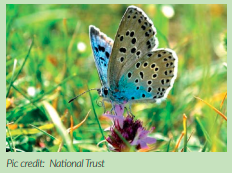
Land owners and farmers ought then to protect hen harriers, simply because it is morally right to do so. Such a notion of rightness by appeal to Kantian ethics can, however, also be applied to the protection of the soil and, hence, the countryside. Those who consider themselves as stewards of the land, take unto themselves particular moral duties or obligations. The claim of stewardship asserts an ethic of duty correlated with an ethic of care. To be a steward of the land, rationally and irrefutably implies a duty to care for the soil which constitutes the land. It follows that this imposes a duty to care for nature which co-exists with healthy and productive soils, as the land. In ethical terms, the soil ought to be regarded as an end in itself and not merely the means to the end of e.g. agricultural profitability. This then compels an intellectual shift which places priority on the soil for the common good of both people and wildlife, establishing, conceptually, the moral right of the soil to be preserved and enhanced.

Assigning value to the moral dimensions of agriculture by means of an ethical lens in order to support practical, on-farm decision making is not necessarily a simple and trouble-free activity. For instance, though we may assert the moral right of hen harriers as an endangered species not to be killed for commercial benefit, e.g. to protect grouse, how does this square with the fact that farmed animals are killed for food? Arguing from a hard animal rights position we may posit the philosopher, Tom Regan’s (1938-2017) view, that animals are subjects of a life and have inherent value: meaning, essentially, that their interest in living and enjoying life is fundamentally the same as that of human beings. Such a position demands, for instance, that animals have the right not to be eaten by human beings (although they may be eaten by other animals).
Meat eating is, however, a cultural norm in many societies and for many millions of often poor people, it can be an essential and not easily replaceable source of nutrition. There is not the space here to analyse the moral arguments for and against the human consumption of meat, but we should recognise that while the justification for granting hen harriers moral rights is based in the rarity of the species, commonly used domesticated food animals are abundant. Indeed, in evolutionary terms, we might consider their success is linked to the fact that they are food for human beings.
If animals are to be farmed, a fundamental moral principle which ought to govern methods of production concerns the ethical principle of nonmaleficence, meaning that whatever one does one should cause no harm. The utilitarian philosopher, Jeremy Bentham (1748-1832) expressed his concern for the well-being of animals, stating: “The question is not, Can they reason? nor, Can they talk? but, Can they suffer?”. Bentham was unconcerned about the use of animals to feed human beings. He believed though, that if they are so used, then as sentient beings capable of experiencing pain and suffering they ought to be kept in ways which prevent unnecessary suffering. Such a position coordinates with the Farm Animal Welfare Committee’s ‘Five Freedoms’, established in 1979, which express normative moral standards for ensuring the welfare of farmed animals: (1) Freedom from thirst and hunger; (2) Freedom from discomfort; (3) Freedom from pain injury and disease; (4) Freedom to express normal behaviour; (5) Freedom from fear and distress.
Agricultural ethics is a large and complex subject which, considered in detailed philosophical terms, can easily fill many text books. Consequently, some topics must be excised from consideration here. However, we cannot leave this review without considering examples of ethical issues which may affect farming in the future: particularly in light of Brexit and the British government’s apparent desire to replace EU policies and standards by integration with America’s corporate agrifood sector. The EU has long presented a barrier to certain patented US agricultural technologies, including, for example, GM (genetically modified) herbicide tolerant crops and genetically engineered recombinant bovine growth hormone (rBGH) (known as recombinant bovine somatotropin (rBST) in Europe).
In ethical terms, new agricultural technologies, which may present benefits and harms, ought to be weighed for approval on a case-by-case basis, objectively and independently of political lobbying and commercial pressures for approval. The EU employs the Precautionary Principle in such evaluations. It emphasises caution in advance and places the burden of proof of absence of unacceptable harms on vested interests seeking approval. However, some British MPs argue that Brexit will permit agricultural and environmental deregulation and they seek adoption of the Innovation Principle, which, in essence, means try it and if things go wrong, try to work out how to repair the damage. This is a morally dubious position.
The evaluation of new agricultural technologies should, of course, centre on scientific evidence, but it should also elicit appeal to different ethical theories. The moral right of people, animals and the environment not to be harmed solely as the means to the end of corporate profit can, for instance, be framed by deontological ethics. To give a few simplified examples, GM technology raises questions about the integrity of species and the right not to be altered by transferring alien genes. The use of routine rBGH injections with dairy cows to increase milk yields raises questions about a variety of consequential harms to cattle as well as the right of consumers not to drink milk containing increased levels of IGF-1 (insulin-like growth factor 1: a hormone associated with cancer in people)
The value of agricultural ethics to the evaluation of new agricultural technologies cannot be understated. It is an intellectual discipline which can provide clarity in problem solving through different ways of thinking. Importantly, it can cause difficult and often uncomfortable questions to be asked, but they are questions that should be asked. In this respect, agricultural ethics is a discipline which ought to be employed routinely by governments in decision-making affecting farming and food. Crucially, if agriculture itself is to continue to serve humanity long into the future, farming will need to adopt a continually reflective disposition which, assisted by ethical analysis, learns from the past in order to chart its path to a sustainable future. Fundamentally, if we as humanity are to survive – an outcome which is not obligatory – we must find ways to produce food which respect and benefit people, biodiversity and the environment. In this, agricultural ethics can play an unparalleled part.
-

Drill Manufacturers In Focus…
WHY BUY A DALE DRILL
By James Dale

Despite the challenges faced in 2020, drill sales have been very good this year, with drills being sold throughout the UK and Norway. Making our drills as versatile as we can is a key aim for us. With all the various features available on a drill, it is always interesting for us to hear which particular element ‘clinched the deal’ for new customers and the answers are often varied…
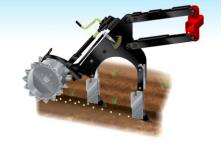
Low Draught, High Output, Less Wheelings
The Eco range of drills are fitted with our low disturbance, 12mm wide tungsten carbide tipped tines. The tines open the soil down to drilling depth, making the drills relatively easy to pull (at between 20-30hp/m).
Many users view this feature as a key benefit to the drill as they can pull a wider working width machine (often significantly wider when considering HP requirements for drills with cultivation elements) with the same size tractor, boosting their output without having to invest in more horsepower. What is more the wider working width reduces the amount of trafficked soil in a field (for example a 3m drill on a tractor fitted with 650 tyres will traffic over 43% of the field, the same tractor on a 6m drill will reduce that number to 21.6%, whilst a 9m drill brings it down to 14.4%). One new customer has switched from a 3m Strip Till drill to a 9m Eco XL, and is able to use the same drilling tractor. Tripling output whilst reducing trafficked soil by around 30% is a real no brainer.
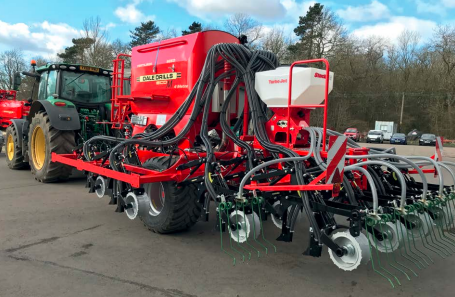
As farm margins are squeezed, reducing costs and diversifying into new revenue streams is more important than ever. Our Eco range of drills not only allow users to reduce cultivations by moving towards a No-Till establishment system, but also allow you to increase drilling output by going wider, meaning the retiring farm hand may not need to be replaced, and there will be more time to devote to the other businesses on the farm.
One Pass, More Applied
As farm margins are squeezed, reducing costs and diversifying into new revenue streams is more important than ever. Our Eco range of drills not only allow users to reduce cultivations by moving towards a No-Till establishment system, but also allow you to increase drilling output by going wider, meaning the retiring farm hand may not need to be replaced, and there will be more time to devote to the other businesses on the farm.
We have seen a significant increase in the number of customers wanting drills fitted with additional applicators over the past few years. The ability to apply a dose of pellets, or control blackgrass with a dose of Avadex at the same time as drilling improves farm efficiency, saving time and money. Our drills utilise RDS Topcon’s Isocan Artemis system, which allows up to 4 channels to be controlled through the drills control box, meaning up to 4 different products can be applied at the same time, their application all automated by the drill. Furthermore, the Isocan system is Isobus compatible so can be run through the tractors screen, decluttering the cab and saving setup time.
Accurate Depth Control
Many new customers opt for an Eco drill due to its ability to establish and maintain an accurate drilling depth. Drills with coulters mounted rigidly to the frame suffer from not being able to follow contours across their width meaning seed can end up too deep or too shallow. The Eco drilling assemblies parallel linkage and depth setting press wheel ensure that contours are followed accurately, allowing operators to determine the depth they want to drill to and ensuring seed is positioned correctly. An adjustable hydraulic pressure is applied to each drilling assembly, meaning the drill can be set to work into loose, cultivated soils as well as hard, dry, uncultivated conditions. This versatility, in terms of being able to work in cultivated, min till or no till seedbeds, is an added draw to many customers who are working towards a no-till system but want to phase out cultivations more gradually, helping soils through the transition to notill, and potentially avoiding yield penalties on the way.
Simple, Low Cost Drilling
Despite offering a huge amount of versatility, our drills are really quite simple. We’ve made significant efforts to reduce the maintenance required on our drills to a minimum, from using oil filled bearings on our press wheels to self-lubricating nylon bushes in our pivot points. Less maintenance means less downtime during the drilling period, helping to boost output and increase farm efficiency.
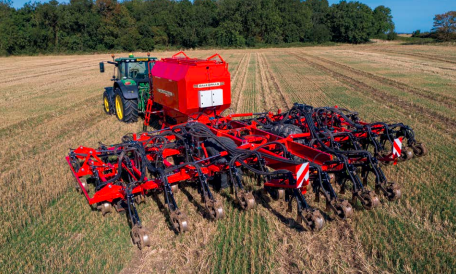
Some maintenance is unavoidable, however access in and around Eco drills is very good, whilst the use of captive bolts and a minimal amount of different sized bolts means you don’t need masses of tools with you. The tungsten carbide tipped, boron steel tines and openers are designed to last, typically achieving over 500ac/m of drill (a 6m drill will average 3000ac on a set of points). This puts wearing metal at under £1/ac, and the long life means less time and money spent on changing tines.
Short Term Hire
In place of traditional demonstrations, we offer our drills on a short term hire basis. If you are interested in finding out more and trying a Dale Drill on your farm, please contact us on 01652 653326, or email james@daledrills.com
-
Are Nitrogen Stabilizers Worth Using? 3 Factors To Consider
Written By Laura Barrera and first published in AGFuse.com
When it comes to fertility in crop production, nitrogen is one of the most critical nutrients involved. “Nitrogen plays an important part in many essential functions and compounds necessary for life,” says the University of Missouri Extension and can be found in various parts of plants.
Unfortunately, nitrogen fertilizer is susceptible to leaving the soil before it can be used up by the plant. According to Cornell University Cooperative Extension, nitrogen loss can occur in three ways:
• Denitrification: Nitrate converts into gaseous forms of nitrogen which are lost to the atmosphere
• Volatilization: Ammonium (NH4) converts to ammonia (NH3) gas which is released to the atmosphere
• Leaching: Nitrate, which is negatively charged like soil particles and not well retained by the soil, is washed downward by excess soil water beyond the root zone of crops.
One way to reduce the loss of nitrogen is by using nitrogen stabilizers. Penn State Extension explains there are two broad categories of nitrogen stabilizer products: urease inhibitors and nitrification inhibitors. Urease inhibitors prevent urease from converting into ammonium, while nitrification inhibitors are actually a pesticide that kills a specific group of nitrifying bacteria that are responsible for the conversion of ammonium into nitrate. While these products can help protect your nitrogen from loss, are they worth using on your farm? More importantly, will they pay off?
Consider Soil Texture
University of Nebraska Extension Soil and Nutrient Management Specialist Charles Wortmann says that like most practices in agriculture, you can’t expect universal benefits from use of nitrogen stabilizers, but it can be very beneficial if it’s well targeted to certain situations. The University conducted a near threedecade study on N-Serve, a nitrapyrin nitrification inhibitor, that was applied along with anhydrous ammonia in the spring on an irrigated, continuous corn field with silt loam soil near Clay Center, Neb. Researchers found use of nitrapyrin produced a positive yield response 36% of the time, which only occurred when weather in the 6 weeks following a nitrogen application included moderatevolume, well-distributed rainfall, or higher-volume rainfall coupled with higher temperatures.
The inhibitor didn’t affect yield in 46% of the years, while there was a negative yield effect18% of the time. Wortmann thinks the results were highly affected by soil texture.
“If it was a sandy loam, loamy sand or sand, we would have expected it to be more beneficial,” he says, explaining that there’s a greater risk of excess water moving through the soil, especially in May and June. Those two months have the highest leaching potential because there’s more rainfall and the crop isn’t using as much nitrogen at that point.
“With a sandier soil, it just holds less water, more water passes through carrying nitrate.”
He says the results from the study tell us that we shouldn’t expect many benefits from the nitrification inhibitor with spring-applied nitrogen for a silty loam soil, silty clay loam soil, or any soil that’s finer textured. The one exception, he adds, would be where there’s a moderate or high due to waterlogging. “In low lands that are occasionally flooded and waterlogged, a nitrification inhibitor could help prevent loss of nitrogen due to denitrification,” Wortmann says.
Weather a Primary Factor
Soil type isn’t the only influence on the effectiveness of nitrogen stabilizers. Because the weather is often one of the driving forces behind lost nitrogen — whether it’s high rainfall that can lead to leaching, or dry weather that can cause volatilization — paying attention to the forecast can play a big role in whether a stabilizer pays off. The University of Nebraska has also looked at urease inhibitors used with surface-applied urea ammonium nitrate (UAN) for corn in central Nebraska for 3 years. They found the urease inhibitor only had a positive effect in one year when there was little rain for 2 weeks after surface application of urea ammonium nitrate. “In this year, the urease inhibitor delayed urea conversion to ammonium,” Wortmann says. “Ammonium easily converts to ammonia which is easily lost to volatilization.”
Studies conducted by Beck’s Hybrids’ Practical Farm Research in 2014 also saw positive results from nitrogen stabilizers during adverse weather conditions. The company tested three products — Instinct, Agrotain Plus, and Nutrisphere-N — on its central Illinois, central Indiana, Kentucky and Ohio sites. The products were surface-applied before corn emergence with 180 pounds of liquid UAN.
They found that across the four sites, the products all provided yield increases and positive returns on investment. Instinct, which delays nitrification but not volatilization, was the topperforming product of the three. Beck’s Hybrids researchers believe this was due to frequent rain events all of the sites experienced throughout the 2014 season.
Results of Beck’s Hybrids 2014 PFR multi-location study on nitrogen stabilizers. Table pulled from 2014 Report.
What About Slow-Release Nitrogen?
In addition to nitrogen stabilizers, another product option are slow-release fertilizers, which help reduce nitrogen loss by limiting how much nitrogen is exposed over time. The University of Nebraska conducted a 3-year study on ESN, a polymer-coated urea, on an irrigated corn field with loamy sand soil in south-central Nebraska. Researchers saw positive results from using ESN over UAN with and without stabilizer at various rates. Averaged across the different rates, corn yield with ESN was 49% greater over unstabilized UAN.
In one year there was a very small rain shortly after UAN application sufficient to activate urease, but then it didn’t rain again for another two weeks, resulting in much ammonia volatilization. The polymer coating of ESN prevented urease access to the urea. A lab study simulating field conditions found that ESN compared with unstabilized UAN reduced ammonia loss by 15% with dry soil conditions and leaching of nitrate by 60%. However, Wortmann warns that while the study was good in testing the effectiveness of slow-release products, it’s not the type of nitrogen management farmers should be following for an irrigated sandy loam. Less nitrogen should be applied early, he says, with most applied in-season, such as through fertigation.
Does Tillage Make a Difference?
With the nitrogen in these studies being surface-applied, does it make a difference what tillage practices a farmer uses? It can. In the 28-year Clay Center study, the site had both no-till and disk tillage. Researchers found no difference in the effects of nitrapyrin due to tillage. Wortmann says that when they sampled for accumulated nitrates in the vadose zone to about a 30-foot depth, there were less nitrates under no-till, but researchers couldn’t find a good explanation for that. He suggests it’s possible that with a better water infiltration under no-till conditions, the nitrogen could have leached deeper than 30 feet under no-till, or it may have been lost through denitrification. Either way, the yield was not any greater.
However, no-till systems often have more surface residue, which Wortmann says increases urease activity, resulting in more rapid conversion of urea to ammonium.
“High residue conditions, high soil pH, and delayed rainfall following surface application of urea are expected to contribute to more benefit from urease inhibitors,” he says. Which is why Wortmann recommends if you’re no-tilling and you’re going to surface-apply urea or UAN, you consider using urease inhibitors, including for corn after soybean. “Unless the weather forecast gives them a strong indication of rain or they’re planning to irrigate,” he adds. “For in-season, whether it’s applied with a land applicator or through the irrigated system, then I do not see a significant advantage to using the inhibitor.”
Deciding When to Use Nitrogen Stabilizers
Unfortunately, because weather is often the biggest factor in whether a nitrogen stabilizer pays off in a season, it’s hard to predict when it’s wise to use them, and when they’ll be a waste of money. “A lot of it is targeting,” Wortmann says. “You have to think about your situation, both your field and your anticipated weather, and decide from there.” In situations where you’re surface-applying urea or UAN, especially in no-till fields where there’s crop residue, then the economics might be favorable, he says. “We don’t have enough data to see how frequently we get these losses.” Conversion of ammonium to ammonia is also more rapid on soils that have a high pH or are calcareous. “Urea application to wheat in spring, I would say that would be a good time to use it. If it’s a rain-fed area, in case the rain comes,” he says. Wortmann adds that if the forecast indicates no rain for 10 days, then he would recommend a urease inhibitor to inhibit volatilization loss. In very sandy soils, even at relatively small amounts, if it’s applied pre-plant in the spring then he suggests inhibitors be routinely used.
“With fall application, it may do some good but very often the effect of the inhibitors is gone by the time we have our highest leaching potential, which is again in March, and probably through May and June,” Wortmann says. “It should be very much discouraged anyway of nitrogen to sandy soil in the fall. But spring application, even if you’re putting on less than 50% of your total nitrogen, you might as well protect that.”
-

Ecological Principles For Weed Management – Steps To Get You On The Road To Making Peace With Weeds
Written by Chloe MacLaren As based on information found on Agricology (www.agricology.co.uk)

Chloe MacLaren is an ecologist at Rothamsted Research exploring how we can design resilient, sustainable cropping systems. Her PhD focused specifically on weed management, but now she works more generally on how different crops and management practices can be combined to maximise both productivity and environmental benefits. Chloe splits her time between the UK and sub-Saharan Africa.

For a long time, the pursuit of effective agricultural weed management tools and strategies was framed as ‘the war on weeds.’ We developed increasingly merciless mechanical and chemical weapons to rid our fields of unwanted greenery, striving toward a vision of pure crops from horizon to horizon.
These days, we’re slowly realising that war is not a helpful perspective on weed management. Sure, no one wants a field full of weeds, but not all weeds are bad, and sometimes the actions we take to get rid of them do more harm than good. That’s harm to both our farms and to our surrounding environment. Furthermore, weeds are proving to be irrepressible opponents; if they don’t like what is thrown at them, they quickly adapt, or a more tolerant species subs in from the sidelines. Making peace with the weeds will cost us less in the long run than trying to eradicate weeds from the fields.
The benefits of learning to live with weeds are illustrated by some recent studies showing that crop yield loss declines as weed diversity increases, and that retaining some weed cover can support beneficial insects as well as farmland birds. Perhaps most interesting is a study from France showing that some groups of weeds – typically diverse, and typically composed of small, lowgrowing species – have no detectable effect on crop yield at all, even when no weed management actions are taken.1 This, rather than weed-free fields, should be our goal.
How do we get there?
Managing weeds for net benefits rather than costs requires an understanding of why different numbers and types of weeds occur in different places, and what can be done to influence that. What, for example, led to the diverse, low-growing weeds occurring in the French study, and how can farmers obtain similar weeds in their own fields?
Current weed science is beginning to answer this question through exploring the ecological relationships between weeds and their environment (disturbance and nutrients) and other organisms (crops, livestock, and wildlife). In this blog, I would like to share some simple principles arising from the study of weed ecology that farmers can look to implement on their farms. These principles should help to reduce the likelihood of problematic weed outbreaks, whilst promoting beneficial weed diversity.
Implementing each principle of ecological weed management should be done with the strategies and tools most suitable to everyone’s own farming system. They can fit conventional, organic or no-till systems, arable or perennial crops or livestock – although how you do it may be very different in each system. I have also shared a few practical ideas of how these principles can be put into practice, although the suggestions are by no means comprehensive (weed scientists have more work to do here, and many farmers may have better ideas about it than we do!).
A key point about following these principles is that they should not be extra work done simply for the sake of weeds. All could also be recommended for managing pathogens and insect pests, contributing to soil health, increasing resource use efficiency and improving yield stability.
Think of weeds as a reminder to manage the farm in a resilient, sustainable manner. Weeds keep us in check as we keep them in check; the more monocultures we farm, the more fertilisers we apply, the more we disturb the soil, and the more chemical tricks we use, the more weeds get out of hand in the long run. If we keep these things to the absolute minimum that we need to support crop or animal growth, then weeds will slowly become more manageable, and possibly even beneficial.
Increase diversity in all its forms
Crop rotation, crop mosaics, crop mixes, intercrops, forage mixes, integrated crop-livestock systems, organic matter sources, nutrient sources, hedgerows, margins, trees, wildlife, microbes. All these are avenues for farm diversification that help to limit weed numbers and to promote weed diversity, by varying conditions in space and time across the farm and landscape, and promoting the natural enemies of weeds. Diversification ensures that no weed species encounters uninterrupted favourable conditions that would allow its population to continuously grow. It also helps to sustain weed diversity, by reducing the chances that some species encounter consistently unfavourable conditions and are lost (think of cornflowers).
Diversification in farm practices can also reduce selection for weeds that behave like crops. The best way for a weed to survive a rigorous management regime is to mimic the crop: germinate with the crop to avoid tillage, tolerate the same herbicide regime as the crop, utilise the fertilisers applied to the crop. This means that the most competitive weeds – the ones that want the same resources at the same time as the crop – are most likely to survive intensive control. If the same crop is grown consistently, its weed mimics will thrive (think of blackgrass in winter wheat).
‘Little hammers’ not ‘sledgehammers’
The phrase ‘many little hammers’ has long been used to encourage diverse weed management practices, and it is increasingly apparent that those hammers must indeed be ‘many’ and ‘little.’ Really big hammers, such as using every herbicide and tillage tool you can get your hands on all in the same season, get rid of most weed species but can select for specific strategies that a few weeds use to avoid all of these. For this reason, variable germination times, fast growth rates and herbicide crossresistance underpin many of the most problematic weeds worldwide. Instead try to rotate tactics between years rather than using everything at once.* ‘Little hammers’ can also be used to shift weeds to more desirable types, by disadvantaging the weeds you don’t want.
For example, taller weeds tend to be more competitive, so tactics that kill tall weeds but allow short weeds to survive can promote a less competitive weed community – mowing, topping or weed wipers might be appropriate, depending on the farm type. *NB: to delay or avoid resistance to herbicides, the evidence so far suggests that using mixes of herbicides each year is better than rotating single herbicides between years, but rotating different mixes of different herbicides is better, and using non-chemical tools in rotation with herbicide mixes is best.
Reduce resource availability
Weeds will grow wherever there is enough nutrients, light and moisture, so try to reduce these opportunities. Competitive crops are a good way to capture resources and keep them away from weeds – choose competitive cultivars, sow as densely as appropriate, and consider intercrops or crop mixes. Combinations of crops with different growing times and growth forms can more effectively utilise available resources than single crops.
Minimise fertiliser applications, and where possible, use slow-release fertilisers (green manures and composted animal manures are a good example). This avoids a big flush of nutrients being available to weeds before the crops can make use of the nutrients. High resource availability also promotes types of weeds that grow quickly – their life strategy is to grab as many resources as fast as possible before anything else (like the crop) does, and this makes them more competitive. In contrast, low resource levels select for weeds that grow more conservatively and impose less intense competition.
Take advantage of the positive effects of weeds
Weeds help to support natural enemies such as lacewings, ladybirds and beetles that eat aphids and other pests. Some weeds also taste better to pests than crops, and help to distract the herbivores. Weed flowers and seeds, as well as the bees, the birds and the butterflies they support are all needed for wider ecosystem health. Weeds can help to shelter the soil from the weather, while leguminous weeds can provide free nitrogen and the long taproots of weeds like dock can bring nutrients up to the surface that will be available when the plant decomposes. Managing for a diverse weed community is the best way to maximise benefits while minimising competition with crops.
Of course weed control will always be necessary to some extent, but in some situations, the cost of the weed control (in terms of money spent, fuel used, soil disturbed and ecosystem function lost) may be greater than the cost of the weeds. The more we learn about weeds, the better we will be able to judge this, improving our capacity to maximise farm productivity and profitability whilst sustaining a healthy environment.
1Adeux G, Vieren E, Carlesi S, et al (2019) Mitigating crop yield losses through weed diversity. Nat Sustain 2:1018–1026.
Header image © Rothamsted Research
Visit www.agricology.co.uk to view this profile in full and see video footage of the farm. Agricology is an independent collaboration of over 40 of the UK’s leading farming organisations sharing ideas on sustainable farming practices. We feature farmers working with natural processes to enhance their farming system, and have a wide range of farmer videos on our YouTube page. We also share the latest scientific learnings on agroecology with the farming community from our network of researchers. Our website hosts over 400 articles on different agroecological practices. In response to social distancing we are hosting a series of online virtual field days on a range of agroecological practices in collaboration with our partners. Subscribe to the newsletter or follow us on social media @ agricology to keep up to date and share your questions and experiences with the Agricology community


-
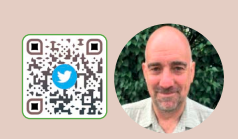
Farmer Focus – Tim Parton
Tim Parton looks to the future in farming and sees microbes taking a leading part in crop and animal production

To quote Rudyard Kipling,
“If you can keep your head when all about you Are losing theirs….”
– seems quite appropriate at the moment. Something, as farmers, we are good at living with, is uncertainty: weather conditions – out of our control; corn prices – out of our control; government legislation out of our control; DEFRA subsidies out of our control. I could rattle on about the suffering and anxiety surrounding the weather, the harvest and re-drilling. Instead, I chose to focus on what I am doing to “keep my head”; concentrating on the things I have control over: Buying my staff breakfast, or an evening drink on those long days of harvest: Thanking Pontesbury Tractors for coming out of hours to repair machinery, so I can get on harvesting in the dry weather before the next downfall of rain: Turning around the disappointment that crop yields are down (remember wet winter and baking Spring?), trusting my gut feeling wheat prices will rise, thus leading to an increased return for my low yield crops.

Challenges faced head on can reveal new ways of working with nature, seeing how nature survives through extenuating circumstances can be an awakening for the human caretaker. On the farm here I have been modifying the 750a (yet again!) with the addition of an air pump on the drill liquid system. This is for two reasons; the first being to keep the biological brew aerated, the second to keep the mix agitated to stop any settling out in the bottom of the tank. This has been done with the help of Trevor Tappin (TT Engineering) and has so far worked well.
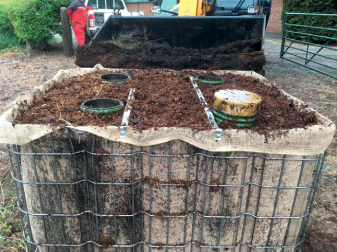
Another new move for me has been the introduction of the Johnson Su static bio reactor, with thanks to Andrew Jackson for the introduction to the regenerating soil diversity system. This is to make a richer microbial compost over the next 12 months in order to apply as a drench at drilling, through the peristaltic pumps: in addition to making compost teas. The real magic of the system is that you only really need two kilogrammes per hectare which will reintroduce a varied biology back into the soil, which mimics the process that would occur on land had it been grazed with livestock. Thus, resulting in improved soil fertility.
As Dr David Johnson, molecular biologist and research scientist says “…. microbes are the backbone of every organism and eco system on the planet….”. Dr Johnson goes on to say that they are involved in human brain development and have a part to play in mental health issues such as anxiety, depression, autism, arthritis to name but a few; being responsible for a large portion (80%) of our immune system. I foresee a future of microbes replacing antibiotics to fight infections, as diseases continue to show resistances to the overuse of antibiotics in medicine.

Doing a similar job on the plants’ immune system you can see why I am keen to put the new system into practice. Dr Johnson has seen 2750 different species of bacteria within compost, with counts of 83 million bacteria and 10 million fungal spores in samples used per square foot, leading to more nutrients becoming available. This in turn leading to an increase of carbon being sequestrated into the soil due to healthier, larger plants.

The reactors are filled as shown in the picture. I am trying different recipes which I will evaluate with a microscope to try and assess fungal to bacteria ratios. The pipes are added to allow air into the bacteria as the compost does not want to be more than twelve inches away from air. Water is added to the compost to keep the correct moisture content. The pipes are removed after 24 hours once the compost has bound together leaving an air filled column.

This year once again I have tried to continue to use biology for disease control. This has worked yet again fantastically well on fusarium and brown rust. Yellow rust has presented more of a problem, resulting in the use (much to my disappointment) of some epoxiconazole. On the positive side it allowed me to learn a lot more about the disease and by doing a lot of leaf tissue tests, Nick Woodyatt (Aiva Fertilisers) and I have a plan for the coming year to once again move still further away from fungicides. Once the nutrition of the plant is right it will not be susceptible to disease. A healthy plant can fight off fungal attacks. In this situation foliar applications of nutritional elements come into their own.
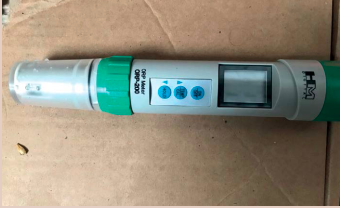
As in a dry Spring such as the one we have just experienced, biology in soil does not function as well, resulting in nutritional deficiencies within the plant. Thus, in my opinion, we will always need to step in and keep the plant nutritionally balanced. This does not really concern me as foliar applications are seven times more efficient than soil applied nutrients. This is far less polluting to the environment in which we live.
Another move for me is to start and monitor the Eh of the plant using a redox monitor, which is a measurement of available electrons in the plant, as well as continuing to measure pH – (availability of protons in the plant). The two complement each other. As I become more familiar with the test it will aid my making decisions on nitrogen requirement and other nutrition, in order for me to keep a healthy plant that will be able to resist disease and fight off pest attack. I believe this will further reduce the need for any fungicide requirements. Another successful trial has been carried out in a Spring barley field following a rye, vetch and bean cover crop.
The following Spring barley crop has only received 40 kilos of applied nitrogen, the remainder being made up of amino acids. No fungicides have been applied to the crop, just biology and the correct nutrition. The combine yield monitor has revealed no difference compared to the more conventional grown barley. However, the real difference has been the fact that the crop had no small grains (as we grade all our grain) and was a much bolder sample. Sample results will reveal a true comparison, but I already feel that the trial barley show what can be achieved from healthy soil, with the correct nutrition. It is all about working with Nature, not against her.
One thing is certain, through these uncertain times, soil will continue to live and evolve, and we must too: and if we do
“…. you’ll be a Man, my son!”
I wish everybody a successful autumn and growing year.
-

Drill Manufacturers In Focus…
SIMTECH T-SEM FOR TRUE VERSATILITY

Simtech T-Sem tine drills are probably the most versatile of all the direct drills on offer today. Their heritage is from the inverted T-slot coulter, initially developed in New Zealand for establishing new seed into living grass, which is probably one of the most difficult of direct drilling challenges. From Simtech importing these drills, the European T-Sem was born and has progressed from a simple 3m machine to the range of drills we see today.
The unique T-Slot coulter creates the perfect environment for seed to germinate and develop. At only 10mm wide at its leading edge it is designed to cause as little surface disturbance as possible. Preceded by a vertical cutting disc, that creates a path through surface trash, the inverted T-slot coulter ensures that the seed is always placed on a firm base, with the vibrating tine creating the tilth to cover it. In soil held together with a large amount of root material the T-slot coulter creates a void in the soil, which is like a mini greenhouse, generating humidity to enhance the speed of germination, but at the same time allowing sunlight to penetrate through the partially open slot. This scientifically proven feature allows small seeds to be placed deeper than would normally be viable into an environment which is much less likely to result in poor germination or seedlings drying out.
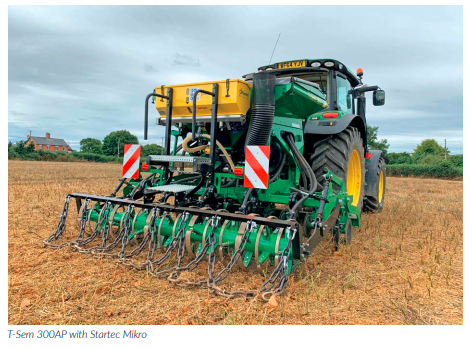
The T-Sem is the ideal drill for a farmer in the early stages of converting to direct drilling.
Versatile enough to cope with all the other drilling tasks such as min-till or ploughed surfaces, but none the less a dedicated and powerful direct drill, able to handle large amounts of surface trash and hard or wet ground conditions. The heavy duty 30mm square double coil tines are strong enough to direct drill crops such as beans to a depth of up to 10cm (4”) in most soils, once again ensuring that the seed is always placed in the correct environment for its development, not at a depth limited by the drills capability.
The T-Sem is also uniquely placed for the establishment of cover crops, which is enabled by its ability to work in high levels of crop residue, without “hairpinning” and at a time of year when the soil can be quite hard to penetrate. The subsequent drilling of the cash crop into the cover crop is also a job that requires the T-Sem’s ability to work in large amounts living vegetation, once again placing the seed in the best environment for its rapid development.
The base arable model T-Sem 3 metre is available with pneumatic or gravity metering. Further models from 3.5 metres up to a new, shortly to be released 8 metre trailed model, are all pneumatic seed delivery, with electronically driven seed metering and computer control. Speed sensing is via a GPS unit and variable rate seeding is possible when connected to a suitable controller.
An additional micro hopper, with independent control is available for all models, which in the case of the pneumatic machines, injects the product into the air flow with the seed. This can be used for starter fertiliser, seed or slug pellets. A further option allows the second product to be metered separately to the individual rows. Liquid fertiliser is also available for all models, with front mounted tanks up to 1800 litres.
All T-Sem drills are capable of drilling into pasture, but where this type of work adds up to a reasonable proportion of your overall workload we recommend choosing our closer spacing models, which can either be the T-Sem 300 with either gravity or pneumatic metering. Or there is a 2 model T-Sem Grass range, which are designed primarily for livestock farmers and contractors. These drills also have the capability to work in quite extreme ground conditions, where large rocks and stones may be present.
In the United Kingdom all sales are direct to the customer and Simtech’s sales and technical team have a wealth of experience, not only in their products, but also of the techniques employed with conversion into no-till.
-
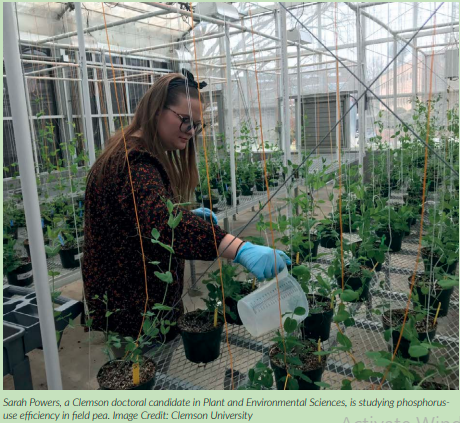
Doctural Candidate Receives Endowment To Help Fund Organic Field Pea Research
Written by Denise Attaway, Clemson University, South Carolina USA
Phosphorous is one of six essential nutrients for plants and a Clemson University doctoral candidate wants to show farmers how organically growing cereal and pulse crops can improve nutrition while lowering production costs.
Sarah Powers is a doctoral candidate in the Clemson Plant and Environmental Sciences Department. Her research focuses on understanding phosphorususe efficiency in field pea. To help fund her studies, Powers has received a Columbus Hamond Townsend Student Assistant Endowment for the second consecutive year.
“I want to determine if it is possible to select cultivars that can sustain growth and yield under phosphoruslimited conditions,” said Powers.
According to the United States Department of Agriculture (USDA), organic farming is a production system that incorporates practices, such as cover cropping and crop rotation, to improve soil quality and build organic soil matter. Phosphorous is a naturally-occurring element found in the soil. All living organisms require phosphorus. Plants use phosphorous for photosynthesis, storage and transfer of energy, and respiration among various other functions. While phosphorus is very important to agriculture, it is a non-renewable resource and cannot be naturally replaced quickly enough to keep up with consumption.
“This can be particularly limiting for organic growers,” Powers said. “Phosphorous-use efficiency will become a greater concern as phosphorous fertilizers become more expensive and difficult to obtain.”
Organic agriculture could benefit from phosphorous-use efficient field pea cultivars by increasing yields and soil nutrition. Greater yields of field pea could benefit health food markets as these peas are highly nutritious and have superior protein quality, Powers said.

Powers’ research is part of a study that involves developing pulse and cereal grain crops that can be grown organically in South Carolina. The study is funded by a nearly $1 million grant from the USDA and is led by Clemson professors Dil Thavarajah, Rick Boyles, and Stephen Kresovich. The USDA is using cooperative research on pulse crops, such as dry beans, dry peas, lentils, and chickpeas; to provide solutions to the critical health and sustainability challenges facing people living in the United States and across the globe.
“Current organic grain production depends on cultivars that have been bred for non-organic production, but these often are not suitable for organic production,” Thavarajah said. “We need varieties that can be organically grown.”
By using organic farming practices, farmers don’t need to buy expensive chemicals and fertilizers. Instead, they use farming practices, such as different tillage methods and cover-cropping for weed control, and biological methods for insect pest control. Organic farming is sometimes equated with lower yields and nutritional quality.
“This research will allow for the breeding of future biofortified field pea cultivars with increased economic returns,” Powers said. “These traits will make field peas more desirable and popular in the organic market, as well as better able to resolve micronutrient deficiencies.”
-
The Question Is, `Why Is Synthetic Nitrogen Burning Carbon?’
Written by Nick Woodyat
Time and time again the main topic of conversation is Nitrogen. Whether from the side of the regeneration farmer who wants to turn the tide from the toxic, expensive inputs, or from the conventional farmer who still believes in the phrase, `Nitrogen builds yield’.
It is my belief that it is the excessive use of Nitrogen that has burnt the life out of our soils much more than any piece of machinery, and it is the farmers’ ‘addiction’ that has allowed the chemical companies to have such a hold over the industry. The abuse of Nitrogen has led to the overuse of other chemicals which has in turn led to the rise of certain issues such as some of the monsters we struggle with today, Fusarium and Cabbage Stem Flea Beetle, along with others. Science gives us a lot to be thankful for, right up to the time that science was hijacked by large corporations; thankfully, many farmers and consumers alike are now starting to wake up.
The Dutch sum up Nitrogen use well in this poignant saying `Nitrogen is good for the father but bad for the son’. From a consumer’s perspective with high Nitrogen under question, the problem is much worse than we realise as most of the salad crops that are bought are just bags of nitrate with little nutritional value, which puts the 5 a day regime into great doubt. It is now also not uncommon to come across issues in food quality such as oranges and black currants with zero vitamin C. University of California studies show that vegetables can lose 15 to 55 percent of vitamin C within a week.
A 2004 study evaluated Department of Agriculture data where the researchers found statistically reliable declines for six nutrients; protein, calcium, potassium, iron and vitamins B2 and C. It has to be concluded that the broad evidence of nutritional decline in our food from intensive systems ran on high nitrogen and pesticides seems difficult to dismiss. What do we do about this? This problem started in the middle of the last century when farmers were told there was a new, easier way of growing more. The system of cover crops and manures went out of the window with the core principles of soil and plant health garnered before the Nitrogen boom of the 1920s, and was replaced by lorry loads of synthetic Nitrogen because it was cheap, but only a limited few had worked out the damage it was going to cause. Since then, we have been confidently strolling down the road of burning off all of the good stuff out of the soil, which led to not only a decline in soil itself but also of course, resulted in lower field health and quality, and yet rising costs.
I can’t argue that synthetic Nitrogen has helped feed the world, but at what cost?
From the outset, it has been assumed that synthetic Nitrogen would build organic carbon even though the truth was exactly the opposite, which is one reason for the global climate change that we are seeing. The thought was that the more Nitrogen you apply, the more growth you get, ergo the more carbon dioxide is pulled from the air. What is now being seen is that synthetic Nitrogen stimulates certain soil microbes which then feast on organic soil carbon, once that carbon is used up the bacteria alter their DNA to survive on ever increasing amounts of Nitrogen. As organic matter is used up, the soils natural ability to store organic Nitrogen runs out. A large amount of Nitrogen then leaches away, fouling ground water in the form of nitrates, and entering the atmosphere as nitrous oxide (N2O), a greenhouse gas with some 300 times the heat-trapping power of carbon dioxide. In turn, with its ability to store organic Nitrogen compromised, only one thing can help heavily fertilised farmland, keep cranking out monster yields: more additions of synthetic Nitrogen meaning onto the treadmill we go…
Almost from the start, farmers put far, far more Nitrogen onto the soil than the crops could utilise, meaning that we started very early on to pollute our water and seas, and tightening our soils pushing out the most important part of it, air. The trouble with synthetic Nitrogen is that it can complex with organic soil carbon, oxygen, and water. This leads to the soil tightening up pushing us to apply more and more, hence a favoured phrase of mine, ‘the moron (more-on) approach.’
A recent researched study has suggested that for every 1kg of Nitrogen that is applied to the soil that isn’t taken up by the plant, we lose 100kg of organic carbon. It is easy to see that intensive farming together with high doses of Nitrogen, with only around 50% efficiency, can already start to cause heavy damage to the environment and atmosphere, giving a large release of CO2 from our soil into greenhouse gasses.
Obviously, the excess usage of Nitrogen has not just meant higher Nitrogen bills, as I touch on above, we see compaction, erosion, lack of water holding capacity and a huge increase in the use of fertiliser. The reason we see so much growth following a Nitrogen application is that the plant sucks up loads of water leading to a massive drop in brix, which then leaves the plant open to pest and disease attack resulting in chemical applications to counteract these factors. Are you starting to see why some are so keen to hang onto this system? Universities and the World Health Organisation both agree that world agriculture, in the current system it is in, has only 60-100 harvests left, which should frighten anyone with children to death! Nitrogen use is the reason for this statement.
How about this statement?
‘The use of artificial manure, particularly synthetic Nitrogen… does untold harm. The presence of additional combined Nitrogen in an easily assimilable form stimulates the growth of fungi and other organisms which, in the search for organic matter needed for energy and for building up microbial tissue, use up first the reserve of soil humus and then the more resistant organic matter which cements soil particles.’
This was by renowned soil biologist, Sir Albert Howard, in 1947, before we understood bacterial DNA and many of the other issues. Did we listen? Did we hell. I now go onto farms where the soil is held together with a polymer glue… Many of these farms have cereals and other crops growing in just the top 2-3cms soil, and a major Magnesium deficiency after just a few days of no rainfall. Good soil structure depends on a living soil and a living soil depends on not using excess amounts of Nitrogen. Water is becoming the new oil of the world and yet by using synthetic Nitrogen we are making the problem far worse than it needs to be, and yet the Nitrogen fixation goes on.
It is strange but many environmental organisations are fighting the damage that has been done to our oceans but ignoring where the problem came from in the first place. Take Chesapeake Bay for example. In 1970, Chesapeake Bay was found to contain one of the planet’s first identified marine dead zones, where waters were so depleted of oxygen that they were unable to support life. Today the Bay’s dead zones are estimated to kill 75,000 tons of bottom-dwelling clams and worms each year. Hypoxia, low oxygen conditions, results in part from large algal blooms, which are nourished by the runoff of farm waste (nutrient run off from the land). The runoff and pollution have many components that help contribute to the algal bloom, which is mainly fed by Phosphorus and Nitrogen. Run-off that we must not forget, has been paid for by the farmer.
The RB209 says that 40-60% of the applied Nitrogen goes into the plant which means it can also be read as 40-60% of applied Nitrogen does not, yet we continue to load our soils. Of course, we must remember that run off comes from organic applications as well, so let’s ask why do we put on more than we need? We also must remember that much of the FYM and chicken muck contains copious amounts of synthetic Nitrogen.
I find it hard to accept, although resigned to it, that the synthetic Nitrogen that we use was first designed as an explosive when scientists found a way to convert inert N2 into Ammonia (NH3) which can be used to feed plants and blow things up. It is suggested that the manufacture of synthetic Nitrogen takes up 1% of the worlds energy which is stunning. We look at limiting factors when growing crops and suddenly Nitrogen was not a limiting factor. Very quickly we went to applying 10 million tons of synthetic Nitrogen to the soils in 1960, but the writing was on the wall. Every older farmer I talk to admits that they have to apply far more to get the same result as the soil dies out from under them. To back this up we used 100 million tonnes in 2005, an increase of 900%.
As we have seen this year (2020) yields are vital. So, the thought of reducing yield puts many farmers off which leads to them being stuck in the chemical trap. However, if we take small steps and are careful with how we move forward, this does not have to be the case.
A great example of this is Tim Parton, farm manager at Brewood Park Farm and a good client of mine. He is Sustainable Farmer of the Year; Arable Innovator of the Year and he also achieved Soil Farmer of the Year in 2017. This year, he is having as bad a year as everyone else following the wet winter and the dry spring, but it is as Tim says in that, ‘when you have good yields in most years your business can carry a bad one.’ This is how agriculture used to be before we lived on the financial edge. I have huge respect for Tim as he is passionate about soils but also passionate about getting viable yields in a sustainable way showing that it can be done, and now many other farmers are following this route.
We do have alternatives, some of which would be incorporating Humates, composts and balanced nutrition. We can invest into our own futures rather than a failed chemical experiment. Obviously, we (the regen boys) are depending on sensible governmental policies which take soil/water health into account as well as working with like minded people who have seen the light. If you are interested in keeping this conversation going, please get in touch: office@aivafertiliser.co.uk. Lets build a better future together, looking into system approaches and most importantly, regeneration.
For those who would like further science behind these statements, there is a wealth of information online as it is all there for those that want to understand and to continue to develop.
-
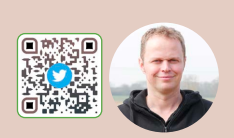
Farmer Focus – Andy Howard

Clean Slate
Harvest has been and gone and was fairly straight forward here in Kent, all bar the Linseed came in dry. Harvest ended well with the Linseed and the Lentils performing well, previous to them it was a real mixed bag. Glad to being starting with a clean slate for harvest 2021. I had my local wildlife officer ring me the other day asking whether I thought our Regenerative practices had given us more yield compared to others. It is a difficult question to answer but my reply was: “probably not, but it cost me less to get the yields we achieved, our soils are in good heart and so don’t need a lot of expensive remediation. This is unlike others who planted in adverse conditions last autumn and have been left with compaction and ruts”.
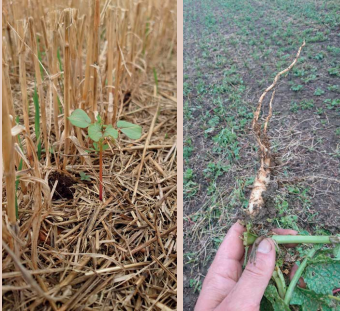
Any soil damage we have is near the surface and we currently have catch crops or cover crops growing to repair the damage. I managed to plant a mix of strong rooting plants on our bare patches on June 19 once we had moisture. You can be seen in the picture they have rooted to a good depth. One of the lessons I learnt from last autumn is that we need catch crops growing before and second wheats or winter beans at least. I kept hearing others say their best establishment of later crops were planted on volunteers or catch crops. As we don’t have the labour to follow the combine with the drill I had to think of other options of getting catch crops established. After much searching and deliberation, I found a secondhand Autocast unit for our combine which was fitted just in time before harvest.(See picture)

Autocasting needs moisture which is something that was lacking at harvest and for a couple of weeks after. For a while I thought my new idea was going to fail. Luckily towards the end of August it rained and now we have a crop. It is current small at the time of writing but still has over a month to go. (See picture) This year I planted a 10-way mix and I will assess to see what grows and doesn’t. First out the blocks have been Buckwheat and Linseed, quickly followed by Phacelia and Berseem Clover.
We did manage to get some catch crops drilled after Winter Barley and these are growing well. These are growing before another Winter Barley crop and the hope is that the catch crop will break disease cycle and add some diversity. (See picture)

All covers have been planted and are growing well, grass seed is just poking through so now we have a few weeks before we start planting more winter crops. A few quiet weeks will be appreciated as the last 12 months have seemed a bit relentless. I think we all need some time to relax and recuperate. Here’s hoping 2021 is an improvement!
-

Drill Manufacturers In Focus…
WHAT WILL THE NEW SEASON HOLD IN STORE?

As part of his ongoing series chronicling events on E. T. Claydon & Sons’ farm in West Suffolk, Jeff Claydon, who invented the Opti-Till® System of direct strip seeding, reflects on last season’s challenges and outcomes, together with how he is approaching the season ahead. The article was written in mid-August.

Most farmers in the UK will be glad to see the back of the 2019/20 season, which was fraught with challenges caused by a triple weather-whammy. Winter was the wettest since national records began in 1910 and on the Claydon farm we recorded only three rain-free days from October through to mid-March. The exceptionally dry spring which followed was, according to the Met Office, the sunniest on record and exceeded the previous UK-high of 555 hours in 1948 by 71 hours. Summer was one of the driest on record.
With all that going on there was never any chance of matching five-year yield averages, much less of breaking records and the Claydon farm was no different.

The difficulties of operating during the COVID-19 lockdown only added to the challenges of farming in an annus horribillis, to use the words of Queen Elizabeth II. Not being a Latin scholar, at times I resorted to more Anglo-Saxon terminology!
Rather than dwelling on problems, I like to take a positive view. When government restrictions prevented Claydon Drills from welcoming the hundreds of existing and potential customers who normally attend our open days in May we filmed a virtual event to highlight the progress of our crops and soils. That was a great success, and you can still view it on the website (claydondrill.com/news/article/virtualopen-day-overview)
Ironically, May was the sunniest in the UK since 1929 and the driest in England with 9.6mm of rain, 17% of the long-term average for that month. On the Claydon farm we had even less. Just 4.2mm of rain fell in May, so the 35.8mm in June really did save the day, but the 48mm in July arrived too late to contribute to yields.
Last season, despite the very wet autumn, all 280ha of winter wheat, beans and oilseed rape went in as planned. The winter wheat was established by 31 October, the last winter beans went in on 19 November and the remaining 46ha of spring crops were drilled directly into a perfect growing environment at the end of March.
The beans desperately needed more rain in May to produce stem and pod growth. The lack of it meant that the crop never grew more than 45cm high but produced a plethora of pods, many of them extremely close to the ground. Fortunately, almost two decades of direct strip seeding using the Opti-Till® System has left our fields very well structured, supportive and almost perfectly level. That was a huge benefit because it allowed the 12m header on our Claas Lexion 600 Terra-Trac to shave the beans off at ground level and recover most of the pods. The task would have been impossible on farms where deep ruts were created by spraying and spreading machinery during the very wet winter, and significant potential yield would have been lost.

The lack of moisture also took its toll on the oilseed rape, which reached a maximum height of 70cm, but it podded well and harvested easily during the last few days of July. All things considered, it turned in a reasonable yield, albeit slightly below our long-term average. Harvest was incredibly early this year, a couple of weeks ahead of where we would be normally, and the wheats fared best. Yields were slightly less than I would have liked but given the extreme lack of rain and very warm weather that was always to be expected. On the plus side, quality was excellent and exceptional hectolitre weights meant no deductions. After getting off to a flying start in April, our spring oats slowed due to the lack of moisture and were yet to be harvested at the time of writing.
All of us will be hoping for better things from the season ahead, but on a positive note, the exceptionally dry spring and summer created an immense amount of soil fissuring on our heavy land which partially offset the negative effects of the extremely wet winter on soil condition.

Hoping for a better season
After harvesting oilseed rape during the last week of July we immediately got to work with our 15m Claydon Straw Harrow to kick-start the process of germinating volunteers and weed seeds. This is a key part of the stubble management process and critical to growing clean, high-quality, high-yielding crops.
Exceptionally hot weather during midAugust made us cautious about using this very useful implement on fields situated close to local houses as working the bonedry soils would have created a lot of dust and probably upset our neighbours. After a spell of heavy rain the Straw Harrow easily produced 20mm of tilth and a carpet of green growth emerged a few days later, so we carried out a second pass to thin the self-set oilseed rape and allow any grassweeds to be sprayed out. The volunteer oilseed rape which remains will act as an improvised cover crop, so it will be interesting to see if this will further benefit soil condition and health, which are already excellent. We will stop using the Straw Harrow three weeks before drilling and spray off any remaining material with Roundup® shortly before winter wheat is sown in early October. It will be interesting to see if this improvised cover crop will further benefit soil condition and health, which are already excellent.
Weather permitting, we will carry out another two or three passes with the Straw Harrow across the other stubbles during the next few weeks to take out as many slugs, slug eggs and volunteers as possible before drilling autumn sown crops. This season we will have just over 200ha of winter wheat, all feed varieties as there are several good homes for those locally. The balance of our 326ha will be 46ha of oilseed rape, 25ha of winter beans and 55ha of spring oats.
Oilseed rape went into wheat stubbles on 8 and 9 August, somewhat earlier than normal because last season we found that drilling on 10 August compared with 10 days later produced an additional 0.25t/ ha. After drilling the oilseed rape, we had five consecutive days of 30°C-plus temperatures which peaked at 36°C and had me worried, but after 25mm of rain the following week the crop got off to a flying start. It looks good, as does the oilseed rape which we drilled for a contract customer who was so pleased with the 150ha that we established for him last year with our 6m Claydon Hybrid because it yielded 4.5t/ha that he asked us to do more this season.

Will cover crops be of benefit?
This season we are experimenting with a cover crop on some of the 55ha destined for spring oats and have drilled Hutchinsons MaxiCover, a generalpurpose over-winter mix containing linseed, buckwheat, phacelia, daikon radish, fodder radish, brown mustard, hairy vetch and crimson clover. It will be interesting to see if it has a positive effect in terms of controlling grassweeds and further improving soil condition.
We drilled it at 12.5kg/ha on 9 August using three approaches. In one area we used the standard Claydon Opti-Till® set-up, comprising a patented leading tine which relieves compaction and aerates the soil followed by a seeding tine fitted with a 20cm A-share. In another area we used the leading tine followed by our new lower-disturbance ‘LD’ twin-tine kit and finally the twintine kit preceded by double front cutting discs which reduce power requirement by up to 50% and minimise soil disturbance.
Changing from the standard seeding tine to the twin tine is as simple as undoing three bolts and takes minutes. With a few simple, quick modifications any new or existing Hybrid drill can now be used for conventional sowing, lower disturbance establishment and zerotill seeding, with or without fertiliser placement between or in the seeded rows, directly into stubbles, chopped straw, cover crops and grassland. This makes them a much more versatile and cost-effective solution compared with purchasing a strip till drill and specialist low-disturbance drill. The two 44mm x 12mm hardened steel tines in the twin-tine unit are four times stronger than normal 30mm x 10mm tines. Fitted with 15mm points, they incorporate unique double-leaf helper springs which maintain a consistent seeding depth even in very dry, hard, heavy soil conditions, yet permit enough lateral movement to displace surface trash and prevent blockages.
This approach provides a more traditional finish than band seeding and the seeded rows from the twin tine setup are normally spaced 150mm apart. The brackets which hold the tines in place can be moved in by 50mm and this allows the width of the seeded band to be reduced to 100mm, providing more space for a Claydon TerraBlade inter-row hoe to take out weeds growing between the rows. This can be done in the autumn once the crops are sufficiently well established, right through until late spring before the TerraBlade would damage the growing crop. The TerraBlade is an excellent mechanical method of enhancing chemical control.
For ultra-low-disturbance drilling of soils in excellent condition the Hybrid drill’s standard leading tines can be replaced with twin 330mm-diameter front cutting discs. These can be either the plain design or new fluted ‘Spiradisk’ which does an excellent job of cutting through trash without ‘hairpinning’ material into the slot and creates a slightly wider channel and just the right amount of tilth to provide perfect growing conditions.
It will be interesting to see how these establishment methods compare, so I will go into more detail about them and our cover crop trials in the winter issue of Direct Driller magazine. In the meantime, you can find out more about the Claydon Opti-Till® System by contacting your local Claydon dealer, calling the Claydon office on 01440 820327 or visiting the website: claydondrill.com. Videos of the new LD options in action can be viewed at claydondrill.com/lower-disturbance.
-

Unlocking Gypsum’s Soil Health Benefits
Applying gypsum in liquid form could prove particularly beneficial in relieving soil compaction ahead of the autumn sowing programme.
It’s been a tough season for soils. Many fields were drilled in less-than-ideal conditions, often after abandoned earlier attempts at cultivation that left soils prone to slumping, while others were left bare fallow which has done little to improve their structure.
“A good number of fields will need remedial action if growers are to get the best out of next season’s crops,” says Agrovista’s head of soil Chris Martin.

“Carefully targeted loosening will be a priority, but on clay and high magnesium soils, I’ll also be recommending a liquid conditioner to aid aggregation, improving workability, drainage and root exploration to optimise crop establishment.”
Liquid Gypsum provides calcium which is needed to flocculate clays, binding smaller particles together along with clusters of sand and silt. This aggregation is one of the most important keys to a healthy soil, providing a favourable structure that promotes air and water movement, biology and increased root development, says Mr Martin.
“Gypsum has been used to good effect in agriculture for more than 250 years, but applying it in liquid form truly unlocks its many benefits,” he adds.
“Liquid Gypsum is highly soluble and weight for weight is around 2000 times more effective than insoluble granular gypsum. It starts working immediately, acting when and where needed to flocculate the soil throughout much more of the rhizosphere than traditional forms of gypsum.”
Soils treated with gypsum require less energy for subsequent cultivations. The product is applied with a conventional sprayer using traditional water volumes, ensuring fast and accurate application.
Annual treatment is recommended, before or during the cultivation programme, at 5 litres/ha. Liquid Gypsum can be tank-mixed with glyphosate so can be applied during routine stubble-cleaning operations. The improved soil aggregation and permeability that Liquid Gypsum brings also provides an excellent starting point for no-till management systems, says Mr Martin. In this case, a primary application at 10-20 litres/ha should be used.

“Soil health is a key component of the new Agriculture Bill, so reduced tillage will be a key factor in improving and maintaining it.
“The use of gypsum to help improve structure and functionality is likely to increase significantly across the UK, as farmers are encouraged to move less soil mechanically.”
Traditional gypsum sources still have a place, aimed at long-term multi-year effects as only a tiny fraction of these sources will be soluble when applied to the soil, says Mr Martin.
“If you want to get flocculation happening close to the rhizosphere and working on the crop you are growing now, the only option is Liquid Gypsum.”
Liquid Gypsum benefits
• Reduces compaction
• Improves soil porosity
• Lessens soil cracking, run-off and erosion
• Improves high magnesium soils
• Improves soil biology
• Supports crop establishment
www.agrovista.co.uk